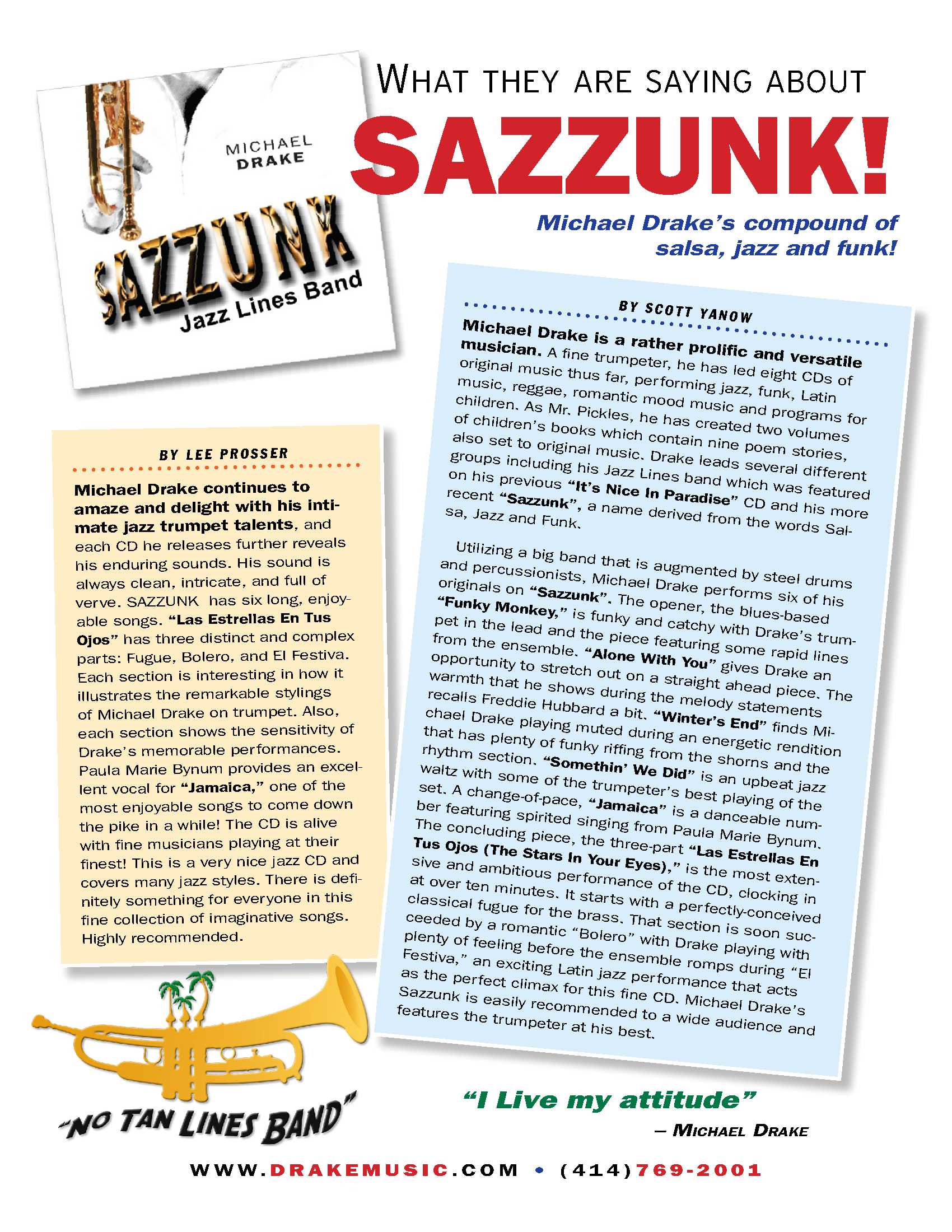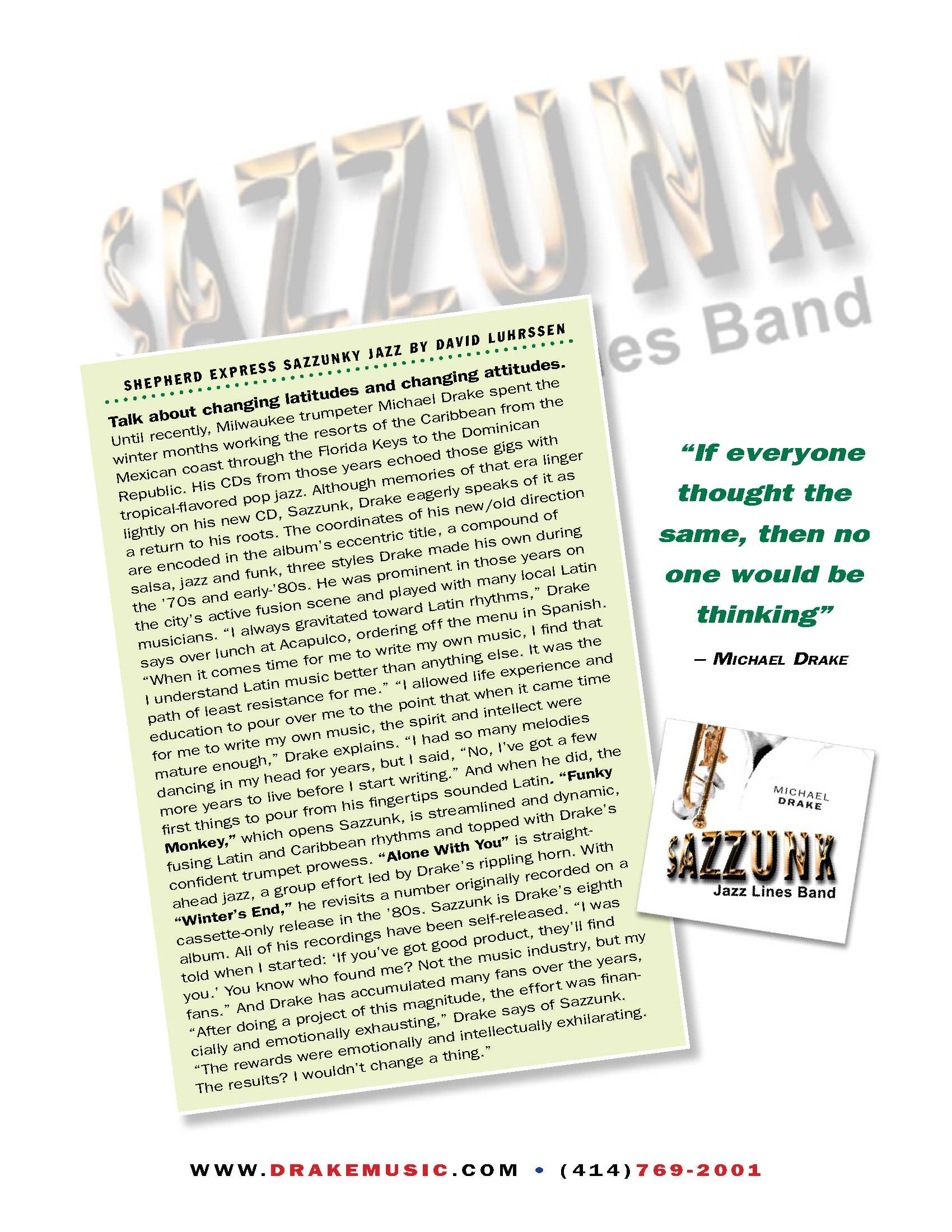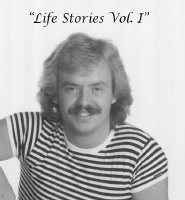
Peruse 56 articles from over 50 years of performing!
My Sheet music is available at  https://www.jwpepper.com/myscore/michaeldrakemusic
https://www.jwpepper.com/myscore/michaeldrakemusic
 CBS 58 Sunday Morning interview
CBS 58 Sunday Morning interview
 with Mike Curkov
with Mike Curkov
 http://www.cbs58.com/news/meet-the-talented-mr-pickles
http://www.cbs58.com/news/meet-the-talented-mr-pickles

The Freeman Waukesha Daily Paper 2016
Serenading Downtown Waukesha
Andrea Fencl
If you attended the farmers market in the past year, chances are you may have encountered a ukulele player serenading pedestrians with personalized songs. Michael Drake, known as Ukulele Drake at the farmers market, has been performing songs on the ukulele in Waukesha for the past year. “The people here in Waukesha are happy people. It's really neat to feel that interaction going on.” Drake said. He started playing trumpet in fourth grade after a man came to his class for show-and-tell with the cornet. In his teens, Drake traveled to Mexico frequently, and after moving to Wisconsin, Drake began playing in Latin bands, influencing his music to develop an island style. “The first gig I had was at a VFW hall and we paid to play. We were doing Limbo Rock, little did I know I would continue to play island type of music,” he said. Two years ago, Drake began performing trumpet in Waukesha with a friend Hal Kacanek and together created 2Trumpets. After Ukulele Drake plays at the market, the two can be found outside Steaming Cup at 11 am Saturdays playing classical music such as Bach and Telemann. “We said, well, let's play on the street here on Saturdays,” Drake said. Drake begin playing the ukulele last November. “I thought this would be fun to do for my kids shows. I integrate the ukulele into literally everything I do, except the classical trumpet, it wouldn't make sense to do that.” He also plays piano and percussion. I could've gone so many different directions as a player. All these different instruments and different things it's like paging through a magazine, what do I want to do, so I said how can I decide?” When asked what his favorite instrument was, Drake said, “Depending on what I'm playing at the time, that's my favorite. When I'm doing the ukulele and I'm entertaining there's nothing more that I like to do. When I'm playing the classical music there is nothing more I like to do. When I'm playing my Jazz stuff that's my favorite--it has to be.” “You don't want to be thinking ‘I wish I was doing something else,’ no, it has to be for that moment. The most important moment of your life is that one that you just lived. Drake said he has performed his entire life, although he considers his early official performances to have taken place during high school. Interacting with people is Drake's favorite part about performing. “When I play the trumpet I have my nose in the music; I don't really get to talk to people--I'm creating an ambiance in the streets. But when I'm at the farmers market I’m one-on-one.” When Drake attends the farmers market as Ukulele Drake, he asks people for their names then makes a song on the spot, putting himself in a sometimes challenging position to create rhymes. Drake also acknowledged the importance of reading people. “Most of the time”, he said, people are willing to have him sing a song using their name, but sometimes people are embarrassed or busy in which the best action is to just move on. The songs are free although he will accept tips. Drake performs for charities, retirement homes, weddings and children's events in which he goes by the name Mr. Pickles.
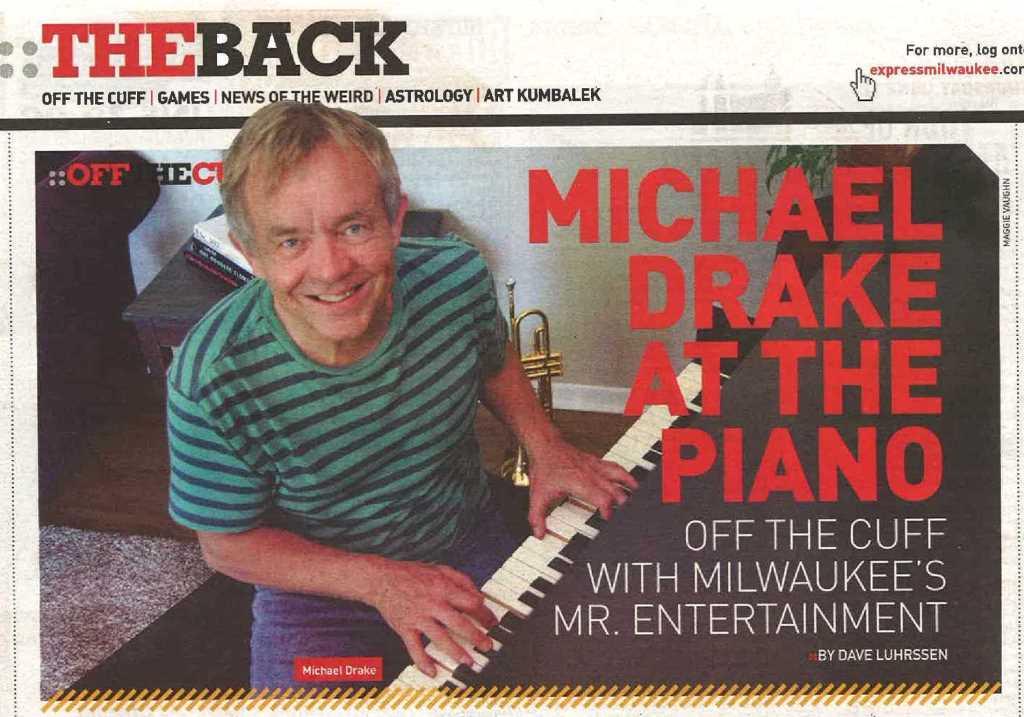
Drake at The Piano
By Dave Luhrssen
“I love entertaining,” says Michael Drake. No one who ever saw him in person would argue that point. A prolific recording artist with nearly a dozen albums to his credit, Drake began as a jazz trumpeter but branched out into Latin and Caribbean-flavored island music along with children’s shows. Never less than fully animated, Drake is a percolating coffee pot of highly caffeinated ideas. Recently, he took up a Wednesday residency on piano at a long running Westside restaurant, Pitches Baby Grand, No band? No trumpet? Just solo piano? Just me and the baby grand with no sequencers. I've always loved Billy Joel and the great piano songsters. And I have re-purposed my island music for this gig as romantic music-ballads. But it’s still all done with an entertainment attitude. It's all about the stories. I tell stories in song. By changing my format to piano, I'm setting the stories in different places. What do you play at Pitches on Wednesdays? It all depends on who’s there. I might noodle and create the wallpaper if the mood is quiet. An entertainer has to read the audience. It can go in any possible direction. Without sequences I can change the character of the song I'm playing on the spot. If someone wants to come up and sing a Beatles song, I'll accompany him. I've got a repertoire of 150 Beatles songs. You take requests? I've got a song list sitting on the piano of 400-500 songs. I've got them categorize. It’s all part of the entertainment thing. An entertainer cannot be selfish. I'm pouring my heart out on that song for the person who requests it. How long have you been making a living at music? That depends on what you mean by making a living! I played my first paid gig in 1967. I delivered the Chicago Tribune newspapers for 15 years. Finally, I was able to get rid of the day job in the early ‘90s. Have audiences changed over the years? There's been a change in receptability. More and more people don't know what entertainment is. It's a conversation! Back when I played weddings, I’d have everyone in the palm of my hand. I still do, but it's more work. People aren't used to seeing entertainers in person anymore. Being an entertainer is a one-on-one relationship--a rapport. You can't get from the TV screen.
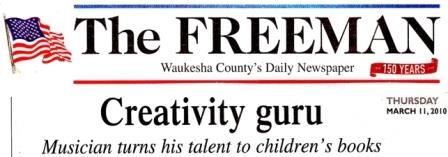
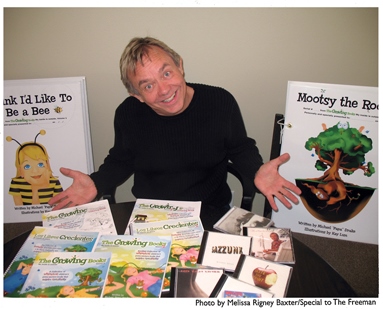
2010
By Melissa Rigney Baxter
The energy is the first thing you notice. At 59, Michael Drake is energetic and excited about all of his ongoing creative projects, and though he participates in a variety of medias, Drake says he communicates in one singular style. Drake is a prolific musician and has performed and recorded solo and with local bands, including The No Tan Lines Band, Jazz Lines Band and Unplugged. His first single “Jessica,” was released in 1980 and became a local hit. He has made several CDs and these days plays at various events, writes music and lyrics. He's added one more number to his repertoire as a children's book writer. After the birth of a granddaughter Victoria, now 4, he begin thinking of some of his children's versus as more than poetry or song lyrics. He begin writing a children's book. “Victoria thinks I'm a star.” So far, the series called “The Growing Books” includes two volumes in English and Spanish, as well as companion coloring books. He published the books through Author House and sells them on his website at  www.Drakemusic.com as well as through Barnes & Noble bookstore and at events. “When I decided I was going to do this, I sent an email to all my contacts looking for an illustrator.” He narrowed the choices down until he selected Kay Lum, a Madison area illustrator. Drake said he worked with Lum to help the words come alive by combining the text, art and colors in a unique way. “The words became part of the illustration.” As a performer himself, Drake focuses on how the books should be read to children. When someone purchases a book from him at an event, he asks them to “audition” their reading skills. “If people buy one, they have to read it first. If they don't read it so kids will be entertained, I won't sell it to them,” Drake said with a laugh. For Drake, fun, creativity, words and music all come somewhat naturally. At times, he said, he has trouble halting his creative process. Melodies and the words of the same thing, 10,000 layers and shades, it's a lot of fun.” Although children's books or a new creative outlet Drake, said he's always interacted with audiences as if everyone is seven years old. “Everything is integrated, it's not just the kids the music, the humor and the words. They are all complements to each other. I couldn't separate them” Drake will be appearing at the Betty Brinn Museum.
www.Drakemusic.com as well as through Barnes & Noble bookstore and at events. “When I decided I was going to do this, I sent an email to all my contacts looking for an illustrator.” He narrowed the choices down until he selected Kay Lum, a Madison area illustrator. Drake said he worked with Lum to help the words come alive by combining the text, art and colors in a unique way. “The words became part of the illustration.” As a performer himself, Drake focuses on how the books should be read to children. When someone purchases a book from him at an event, he asks them to “audition” their reading skills. “If people buy one, they have to read it first. If they don't read it so kids will be entertained, I won't sell it to them,” Drake said with a laugh. For Drake, fun, creativity, words and music all come somewhat naturally. At times, he said, he has trouble halting his creative process. Melodies and the words of the same thing, 10,000 layers and shades, it's a lot of fun.” Although children's books or a new creative outlet Drake, said he's always interacted with audiences as if everyone is seven years old. “Everything is integrated, it's not just the kids the music, the humor and the words. They are all complements to each other. I couldn't separate them” Drake will be appearing at the Betty Brinn Museum.
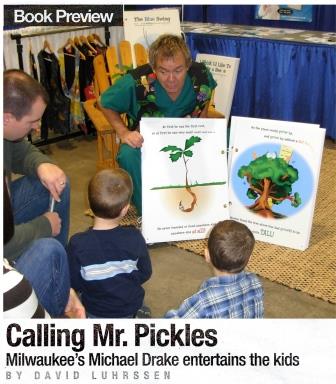
Shepherd Express 2010
Michael Drake is like a house with many additions, with each new wing flowing openly into the original floor plan. The Milwaukeean made his name in music, playing Latin jazz and upbeat fusion before latching on to what he calls “Island music,” smoothly syncopated with a Caribbean lilt. Inspired by his grandchildren, Drake began writing humorous verses with the idea of producing illustrated children's books. Lately, he juggles animated “performance reading” from those books with his ongoing musical career. Sometimes, the music and the kids’ versus meld into one. My persona when I read from the books, is Mr. Pickles.” A man born to be on stage--any stage. In part his enduring career in music is based on his personable demeanor. He has always been determined to make everybody in his audience happy. Entertaining the toddlers was one easy step. So far, Drake has published the first two volumes of his series, The Growing Books, along with a bilingual English Spanish edition and an accompanying coloring book. The translation into French is in the works. A believer in giving back, Drake donates a portion of the proceeds to Children's Hospital. “As a songwriter since the 70s I wrote my own words. I always wanted the words to sound like the music, highlighting the seamless flow between the whimsical verses, such as Dancing with Mr. Brussel Sprout and To Bee or Not To Bee in the colorful illustrations by Madison artist Kay Lum. As our grandchildren came up the desire to write these things was overpowering. ‘No’ was not in my vocabulary! ‘Know’ was, but no ‘no’ I just had to do it!
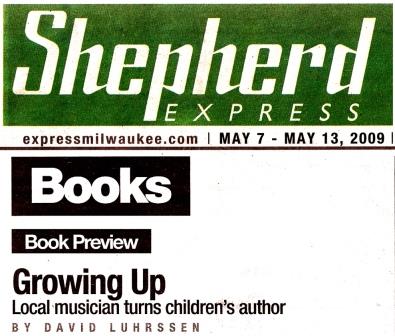
Trumpeter Michael Drake is a familiar name to long time music fans around town, a Latin-smooth-Caribbean-Jazz player with eight CDs and 30-plus years in his resume. But recently the musician took an unanticipated turn: He became a children's book author. The biggest inspirations were his grandchildren; Victoria, 4 and Ferris, 1. Drake begin writing curious verses to entertain them, remembering that his grandmother did the same thing when he was a kid. “And then my wife, Lori, talked about writing a cookbook for kids. A half-dozen things were hinting at me to do this.” This became an ambitious scheme called “The Growing Books,” each installment a set of poems with verses brightly illustrated by Madison commercial artist Kay Lum. Circulating word of his project online, he received submissions from some 50 illustrators nationwide. Lum impressed him most: “When I first viewed samples of Kay’s art on her website, I said to myself, ‘Yes!’ I loved her style, and frankly I was tired of looking at submissions that were good but just didn't get to me where it counts. Thus far, Drake has published two volumes of “The Growing Books” in several formats, including DVD (with his own voice-over,) coloring books, CD (with downloadable text) and out shortly traditional perfect-bound books. He is working on translating his whimsical poems, with titles such as “Mootsy the Rootsy” and “I'm a Dreamer” into Spanish. “We really click creatively’” Lum adds, “We inspire each other's ideas and bounce them back-and-forth until we come up with what we feel is the perfect solution, laughing most of the time!” And laughter is Drake’s calling card--great gusts of laughter. As a musician he always looks as if he's having a terrific time, and one easily imagines him shifting gears only slightly to entertain children with this spoken words.
Shepherd Express 2008
Warm Weather Cruise / Skipper Michael Drake sets sail
By David Luhrssen
Long as anyone remembers, the Iroquois made its way along the Milwaukee River every summer, saluted by raised drawbridges on its way to the harbor. The pleasure boat has carried generations of sightseers onto the water during the warm months. What better entertainment for the Iroquois' first cruise of the season than a shipboard show by the No Tan Lines Band, purveying what bandleader Michael Drake calls "Island Music." Drake, a trumpet player, is no slouch on his instrument. The one-time spokesman for Getzen trumpets became known as early as the '70s for his proficiency in a variety of Latin and fusion settings. Since then, he's become a prolific recording artist and songwriter releasing no less than eight CDs. I has also cultivated an easy shtick as an entertainer, a trouper determined to raise a smile from audiences that raise their plastic cups of beer in return. Drake has become an outdoor festival and private summer party monster, his sunny disposition as warm as the season's weather. Drake's island music is a splash of Jamaica, a jigger of Trinidad, a pinch of Brazil and a slice of Cuba shaken and stirred. He serves it along with hula-hoop and sing along contests to maintain the party ambience. ''I love those rhythms, so wild and varied, I combine all these Influence. I'll go with happy, upbeat music from anywhere the weather is warm.' Until recently, Drake spent the winter months playing the resorts of the-Caribbean from Cancun through the Florida Keys. "It was a great timer hut it got a little old. I wanted to be back here and be with my family. But I'm the Island guy in town. It Makes sense to book me on a boat tour." Along with the "'don't worry, be happy" sound of the No Tan lines Band, Drake plats straight Jazz on other occasions, conducts music clinics and workshops and is developing an exercise DVD to the beat of his music. He's even begun writing children's books in cleverly wrought verse, 'Creativity, the destination is always around the corner. I'm always hungry for something else."
Elm Grove –NOW 2007
"Michael Drake Celebrates 40 Years of Music Inspired by The Islands"
Musical Dynamo
By Alan Hamari
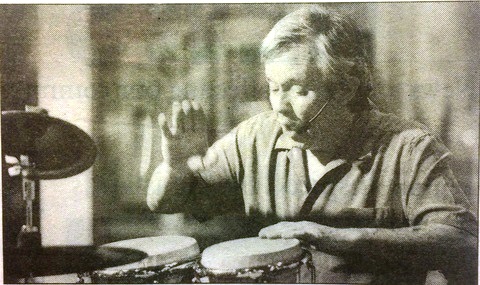
Drake has also earned plenty of praise from friends he has made in the industry.
Milwaukee Post 2007
Always The Entertainer
40-year music career continues to evolve for Michael Drake
By CHRISTY SNEIDE
Michael Drake is still living his dream, captivating audiences with his dynamic tropical jazz and invigorating trumpet sounds. For nearly three decades he has played his music professionally on the Milwaukee scene, establishing himself as a respected artist and successful musician. Performing live recently, Drake and his three-piece No Tan Lines Band play harmoniously for a private party at Riptide Seafood Bar and Grill, 649 E. Erie St. Drake plays trumpet, percussion and provides vocals, while Domingo Toro plays the congas and Paula Bynum sings backup and accompaniments with the maracas. The trio produces a distinctive sound that combines Latin jazz and Caribbean beats with the crisp melody of Drake's trumpet solo. A true entertainer in every sense, Drake's showmanship dazzles a crowd and sets them in motion to jive. He makes an extended effort to engage the audience with his music; walking around tables situated around the dance floor with drumsticks in hand, Drake taps them together to the beat of the congas. With microphone on, he approaches nearby guests sitting along the bar and sings to them. Drake enjoys the crowd and even dances with a few women gravitating toward the band, to the tune of "You make a Difference in My Life." "Tonight our world is musical wallpaper," Drake said "It's nice to have the band, but it's not really why people are here". This is an after-work party for people to wine and dine, socialize and network. Drake has been playing his music for 40 years. Although he has made a name for him self as a musician in Milwaukee he is not a native. He moved to Milwaukee from Tulsa, Okla., in 1971 with his parents and stayed here to continue his education at the University of Wisconsin-Milwaukee. He began playing trumpet professionally with local Latin bands that played traditional orchestra standards like merengue, salsa and bolero.
He also played in American bands that played standard classics like "Misty" "September Song" and "In the Mood." Eventually this exposure led him to branch out and form his own band, Nexus. In the 1980s, Nexus became known for its jazz ' fusion musical style. Later his music-evolved into a Caribbean style, and in the 1990s, he began playing in places like the Florida Keys and the Caribbean during the winter months. "This is how I became coined the Jimmy Buffet of the Midwest," Drake jokingly admits.' Throughout his career Drake has played in local country clubs and bars, at private parties and at Summerfest and Jazz in the Park. He's performed in Canada and the Dominican Republic. Drake has declined offers to play on cruise ships for six months at a time since "that's too confining," he says.
"As a musician you wear many hats, You wind up doing all these things at the same time: designing, playing and maintaining your emotional stability" Drake equates his music career to the-spokes on a bicycle tire supporting a frame. He constantly ponders, "What spokes do I need to work on to make my tire become sturdier and faster? A lot has changed in the music scene, I’II generalize it:
a lot less live music and more DJs." Drake says bands have typically tried to redefine their concept and play just one kind of music style. These bands have narrowed their song lists and "shot themselves in the foot." There are less variety bands playing today because DJs are the ultimate in song variety he says. "There was a time when the band would move wherever the audience was. Now bands move the audience," Drake said. "Years ago the band would have a conversation with the audience. Now, bands have set agendas and play only what's required. `Here's my set - take it or leave it"' "Many bands have stopped reading and working the audience," he says "DJs at least work with the audience." Drake remembers in the 1970s when everyone played all the music. That provided more opportunities to play
"Back then we were able to make it happen. Today fewer musicians read sheet music. They typically learn a few songs off a recording, and that's it. Back in the day it was expected that we know how to play a variety of 300 to 500 tunes, and be real," That's where my roots come from, I would string melody songs together and ad-lib them as the evening went on." Today Drake is making a concerted effort to make his new album nationally recognized and introduce listeners to the other side of his music. "Intellectually, there is another side of me people might not know," Drake says. Drake keeps the dream of playing internationally alive and being recognized for the work he does. "You can either have a small project and spend your life creating that, or create a big project and let them find you," Drake says. And that is exactly what Drake hopes for with his new album, SAZZUNK, a blend of salsa, jazz and funk. The music on the recording is all original and can accompany a solo to a 25-piece band. When Drake is creating music in the studio, he is immersed in every detail.
"It takes about three to four months to experiment with many layers of sound in the production aspect," Drake says.
"Blending flavors and spices to get the vavoom, everything has to be balanced. It's really involved art."

2007
Welcome to Drake's Musical Paradise
By Jim McLoone
Who would believe that Michael Drake, now at the ripe old age of 56, cut his eye teeth in the musical world as a teenage trumpeter playing for as little (or as much as) $5 a gig along the east coast of the United States, playing in bars, veteran' clubs and on small stages. The veteran trumpet player, whose music is said to be like a breath of fresh air, now lives in Brookfield with his wife, Lori. On stage for 40 years and with a trumpet in his hands since he was eight yews old, Milwaukeeans have had the privilege of hearing his quality music since 1971. Drake has been and still is a one-person show on numerous occasions and at many venues, but he is the leader of the No Tan Lines 18 piece band, which as listener, Tom Purdy of Marketing Images, says, "Dust me off, I’ve been sitting on the shelf too long. It (Drake's music) cures my cabin fever like a margarita slakes my thirst.” Drake, in his earlier and leaner years in the Greater Milwaukee urea, also played at various times with the popular Steve Swedish band and that of long ago society band maestro, Dave Kennedy. Now for more about this colorful musician whose eight recordings have been positively touted in the music loving community in many complimentary ways, like "the hippest trumpet player alive. Chase those winter blahs away. Bring your dancin' gear and beach tongs to Michael Drake’s fabulous island. " So said Paidraig Fionn of Steppin’ Out Drake was hooked on music after he heard a classmate play his trumpet at "Snow and Tell" in third grade. He coaxed his parents into buying an instrument. They bought a bugle and abort a month latch after listening to him make melodic sounds, they splurged and bought him a cast off $5 cornet, which he still has along with nine other horns. Michael played through high school, was a member of a popular Tulsa. OK. jazz band when he was a high school senior and went to the University of Tulsa on a music scholarship. The Drake family came to Wisconsin when Michael was 20, he entered UWM and almost immediately began playing with local Latin, jazz and society bands. His talents brought him no end to offers. His first band, "Fusion," in 1967 was immediate hit, playing five nights a week and featured on a local television show. His first original music recording was "Jessica," an immediate local hit for him reaching number four on the pop play list at radio WLUM. Obviously, this first "Jessica" had to be before he met his wife, Lori, at a band concert. Lori, who plays mostly classical piano music, has a talent not quite like her husband's, but they have been together 33 years and are still in love. You can see it in their eyes as they converse. They have a son, Adam Sean Drake in the financial business; "It's a pretty steady and profitable gig," said his proud father. Michael's CDs include Life Stories Volume I, Welcome to My Island, No Tan Lines, Taste the Fruit, Savor the Moment, It's Nice in Paradise and his latest, Sazzunk. What in the name of Drake you may ask is Sazzunk? Michael said, "Since it is a combination of salsa, Jazz and funk, I named it Sazzunk." "Welcome to My Island" CD was so hot the Leblanc Holton company of Kenosha placed Michael Drake in their list of lecturers and performers. He also continued his concert series with schools and other gigs. Later, he produced "It's Nice in Paradise" with a Getzen Company, Elkhorn, WI. "Renaissance" trumpet. Drake now appears at concerts, clinics and music camps everywhere showing off his talents and the Getzen products. To this day, Drake also appears as a soloist, with ensembles and up to and including leading his 18 piece
Caribbean jazz, dance and show band. Among notables he's played with were as band leader for Cab Callaway, on the Bob Hope show and with Doc Severinsen, who also at one time Appeared for Getzen products. Drake might vie with the governor, mayor or county executive for the amount of space that has been given to him over time in newspaper and magazines touting his talents and that of his "No Tan Lines" band. He's a musician, composer, recording artist, entertainer, clinician/speaker, and as he will admit, his performances are considerably cheaper than an airplane ticket to Jamaica as WMSE disk jocks proclaim. But because of his many talents, Drake has been selected to be the first director of the Bob Kames Foundation "H.S. Jazz All Stars." This will be a band of the very best high school musicians in Wisconsin. All musicians in the band must audition for membership. Drake said this performing group will make appearances all year long and will be on stage at Summerfest July 7 and later at the Wisconsin State Fair. He expects band members from a minimum of 17 Wisconsin high school bands to audition. Bob Kames Jr., is leading the foundation in his father's honor. "Dad helped many young musicians," he said. "To me know, it is all about kids." Bob Kames, Sr., will be remembered for his "Chicken Dance" fame as well as the owner of a music store. A guest soloist since he was a child and a music writer for about 15 years, Drake says that when he performs he wants it to be a really great experience, for himself, his band members and those in attendance. As the talented Ellen McDonald of Hartland Music says, "This is happy music. It puts listeners in a great mood." Even those who aren't "into music" seem to find their feet moving when they're listening to a Michael CD. If you're interested and why wouldn't you be, you can listen to 30-second samples of songs from his CDs at  www.drakemusic.com.
www.drakemusic.com.
Mr. Entertainment
By DAVID LUHRSSEN
Forty years ago Michael Drake played his first paying gig, a “How low can you go?” limbo contest at a New Jersey VFW post crowded with sailors. “I think I made $5,” the trumpeter fondly recalls of his teenage debut. And he’s still fond enough of the limbo to include it in his shows, along with Hula Hoop contests and conga lines. Drake has been eager to please local crowds since moving to Milwaukee in 1971. He has played in the long-defunct society bands of Dave Kennedy and Steve Swedish, the once-common Top-40 acts celebrated in Adam Sandler’s The Wedding Singer, in ’70s fusion bands and a Caribbean smooth jazz analogue to Jimmy Buffett, not to mention Latin and straight-ahead jazz combos. Beginning with his 1980 local radio hit “Jessica,” whose style was compared to Chuck Mangione, Drake has been as prolific in the studio as he is with genres. His latest CD, last year’s Sazzunk, is his eighth album and represents a more serious exploration of jazz. “People have me pigeonholed as an entertainment guru,” says Drake, as irrepressible in person as onstage, where he puts a premium on keeping the mood upbeat and happy. “I don’t mind pigeon holing it’s been a wonderful journey for me! But I genuinely have a reverence for jazz. I love playing it! I feel that if people like me as a person, then they’ll listen to my music and then I can sneak in a few jazz riffs. I start by playing the tune everyone wants to hear and turn to the tune I want everyone to know.” It’s been a 40-year juggling act executed by Drake with professional aplomb. Leavening his need to be embraced by enthusiastic audiences (earning him a busy schedule of private parties, summer festivals and bar gigs) is his dedication to the craft of jazz trumpet and a desire to pass his enthusiasm and skill on to new generations. Between music-store workshops and seminars with high-school jazz orchestras, Drake has become as much an educator as an entertainer. “I know one thing: It would be a lot harder to get started these days,” Drake says, comparing 2007 with the era when he began. “There were more places to play. And ever since DJs came along, they have filled in where bands used to be. But without live music, you leave out the ingredient of entertainment. I see a difference in the way people react to music lately some people don’t necessarily react to entertainment. They don’t understand what entertainment is about anymore.”
Drake, however, hasn’t forgotten how to entertain, and continues to put on a show almost contagious in its good spirits.
Sazzunky Jazz
By David Luhrssen
 www.JazzReview.com
www.JazzReview.com
Sazzunk 2006 Various Jazz Styles
By Lee Prosser
Musicians: Michael Drake (trumpet), various guest artists including Ken Kosut on piano, Mike Powers on baritone saxophone, among others. Michael Drake continues to amaze and delight with his intimate jazz trumpet talents, and each CD he releases further reveals his enduring sounds. His sound is always clean, intricate, and full of verve. This CD collection has six long, enjoyable songs. The titles are "Funky Monkey," "Alone With You," "Winter's End," "Somethin' We Did," "Jamaica," and the intricate "Las Estrellas En Tus Ojos (The Stars in Your Eyes)." "Las Estrellas En Tus Ojos" has three distinct and complex parts: Fugue, Bolero, and El Festiva. Each section is interesting in how it illustrates the remarkable stylings of Michael Drake on trumpet. Also, each section shows the sensitivity of Drake's memorable performances. Paula Marie Bynum provides an excellent vocal for "Jamaica," one of the most enjoyable songs to come down the pike in a while! The versatile Johnnie Padilla plays piano and flute on "Las Estrellas En Tus Ojos." “Alone with you” shows Theo Merriwether on piano, at his best. The CD is alive with fine musicians playing at their finest! Jessie Kuscinski excels on steel drum, and Eric Larsen gives the listeners some nice trombone sounds. This is a very nice jazz CD and covers many jazz styles. There is definitely something for everyone in this fine collection of imaginative songs written by Michael Drake. Highly recommended.
CNI (My Community NOW) Bay Viewer 2004
Self-made musician boasts varied styles, big dreams
By Carrie O’Connor
Tonight Bayview musician Michael Drake will do what he enjoys most, he’ll gather his 18 piece band and be the impetus for one heck of a party. He’s also celebrating his birthday, which was on Tuesday, while playing a benefit for Variety Club Children's Charities. “I can feel my age a little, admit,” said Drake, 53, who performs more than 200 engagements a year. “It's harder to bounce around from gig to gig then it was 10 years ago. I still hope to have the natural progression of a musician and go beyond Milwaukee.” Hopes for recognition: Drake has recorded a total of seven CDs. He said he enjoys influences from around the globe. After recording his latest CDs, which features his unique blend of Caribbean, calypso, reggae and Latin, Drake said that like all musicians, he looks forward to national recognition. His most recent CD is “It's Nice In Paradise,” which was completed two years ago. He used a Getzen “Renaissance” trumpet in the studio. Two years before that he produced “No Tan Lines.” In one CD project, “Taste The Fruit,” videos are included as are nine recipes from the chef at Shaker's Restaurant in Walker’s Point. Among Bob-a-Loo’s recipes are “You'll Never Go Back to Anything but Shark Skin Soup,” and “Gloriously Luscious lime Scallops.” The “Taste The Fruit” CD idea came to Drake after 30 years in the business. Earlier CDs include “Welcome To My Island,” “Life Stories Volume I” and “Jessica.” Passion is music. He supplemented his income for 15 years, beginning in his 30s, with a paper route to begin at 4a.m. He also drove a school bus. “I have a strong passion for this business, this is a hobby that turned into a living.” He began his career when he was a child. He played the trumpet in high school in New Jersey and Oklahoma. “It really bothers me today when I hear college kid saying that they don't know what they want to do. They haven't declared a major. I just want to say, ‘Get a job.’ I was born with the work ethic.” He received a scholarship to the University of Tulsa. He moved with his family to Milwaukee shortly into his college career. He started playing with the local Latin jazz bands and formed a band that played five nights a week. Drake has learned to be his own marketer. He has contact with 50 agents in the city, adding that he has learned how to work at self-promotion and business incrementally. “Wouldn't it be terrible if you became successful overnight and didn't know what to do?” He rattled off a few expenses -- $5 dollars for an individual press kit, $15,000-$20,000 to record a CD. The only break that he has as a musician is working out of his home studio. “That is a tax write-off.” He said he bought quality equipment early in his career. Quality he said is everything. His originally arranged music consists of four trumpets, four trombones, five saxophones, a four piece rhythm section and his solo or lead part. Drake now has season musicians with positive attitudes and abilities. “The rewards are daily. You have to work hard to have the end results. You create your own opportunities.”


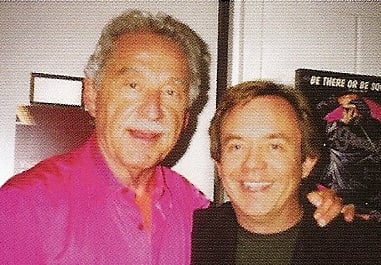
Above, Michael Drake L-O-V-E-S his 3001LE Custom trumpet while representing Getzen at the International Association of Jazz Educators meeting in Toronto in January, 2003. Michael recently did performances and clinics at the University of Tulsa and at several locations around Wisconsin where his "No Tan Lines" band is based. (Michael is also pictured far right, backstage with Doc Severinsen at Milwaukee's Marcus Center for the Performing Arts.)
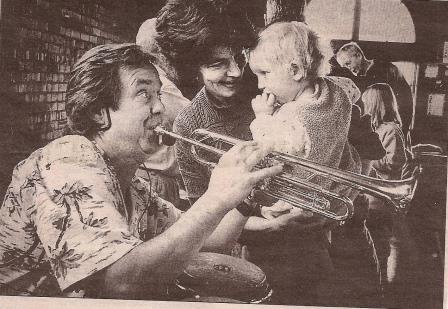
PERSONAL PERFORMANCE — Musician Michael Drake performs for Patty Berg and son Adam Burrows, age 1 1/2, during the Winter Fun Event at the South Shore Park Pavilion on Sunday. Several hundred people attended the event with games, food, music and a chance to learn about the many community groups serving Bay View.
Shepherd Express 2001
Tropical Vacation CD “It’s Nice In Paradise”
By Dave Luhrssen
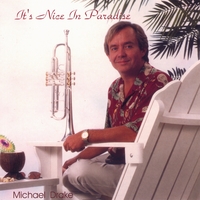
As a musician and a businessman and educator and entertainer, trumpeter Michael Drake wears more hats in a single week than most of us have in our entire closet. One day he’s doing a music store workshop for Getzen, the trumpet maker he signed an endorsement deal with last year: next it’s a club gig. One day it’s a seminar with a high school jazz orchestra, then a trade show or a company party.
Somewhere along the way, ha has managed to release seven albums. The Latest, “It’s Nice In Paradise”, reiterates the Caribbean-flavored smooth jazz themes already apparent when he issued his first recording in 1981. With melodies as crisp as white sails against an azure horizon of rhythm, “It’s Nice In Paradise” is an aural replication of warm sun and tropical drinks, the kind that sport there own umbrellas.
Paradise also features some sterling playing, especially the interplay between Drake and saxophonist Scott Kleist. “When I listen to my old recordings I hear the same guy I am today,” he says. “It’s a good feeling. My point of view has been consistent. My challenge is to remain creative within a framework of similarities.” Drake knew he wanted to be a musician since his childhood. Along with building a formidable set of chops, he realized that he had to learn how to sell his skills if he was going to play for a living. “If you really love what you are doing, then you’ll conclude that the right thing to do is to promote it, share it and not keep it to yourself. If you’ve worked hard on your craft, why wouldn’t you feel the urgency to sell it?
Journal Sentinel 2001
Drake breezes along with Caribbean Sounds
By Dave Tianen
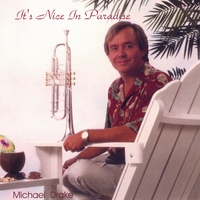
He has more titles than the new member of the royal family: Milwaukee's Calypso King Milwaukee's Caribbean Dance Disciple, Milwaukee's Resident Calypso Master Milwaukee's Jimmy Buffett. Trumpeter Michael Drake is a musical beachcomber by way of such exotic climes as New Jersey and Oklahoma. One of Milwaukee's busiest musicians, Drake came to town in the early 70s after attending Tulsa University. Over the years, he has proved to be one of the city’s busiest musicians, playing as many as 250 dates a year. He's also been a fairly consistent recording artist releasing four albums in the last four years. His newest disc is “It's Nice In Paradise,” was just released by Getzen Co. the Elkhorn- based brass instrument manufacturer. Drake plays Getzen trumpet and makes appearances on behalf of the firm at trade shows and schools. He expects to be featured in the company’s next catalog. “I'm thrilled that I actually like the horn,” he said, “I cannot be less than straight about that.” Now that he's 50, Drake is cutting back to about 200 dates a year, many of them corporate dance parties that he plays solo or with the band. “There were times I was doing two or three shows a day,” he said, “At 250 shows a year, I was just shot. That's brutal. This time of year, I probably do more corporate shows then club dates. In the winter, I try to limit my travel to a 100 mile radius. I get so busy in the summer I make most of my money from May to September.” Although he's an instrumental artist who counts Herb Alpert among his early prime influences, Drake has no complaint if people choose to compare him to beach rocker Jimmy Buffett. “ I love that,” Drake said. “If somebody looks at me and thinks of Jimmy Buffett that's great. I call what I do vacation music. Comparing me to Jimmy Buffet, that's a compliment. I think it's a good thing.” One of the oddities of Drake's career has been that he's chosen to concentrate on calypso when reggae has been more popular for decades. “Calypso is a bit more up-tempo and fun,” he explained. “Reggae is darker and more political. I prefer the energy you get out of Calypso.”
2001
It's Nice In Paradise”

Musicians: Michael Drake, trumpet, timbales, percussion, keyboards, vocals. Paul Marie Bynum, vocals. Scott Kleist, vocals. Diana Kleist, vocals. Lynda Lee, vocals. Kevin Carberry, horn arrangements on tracks 3,5,9. Compositions by Michael Drake. Review: IT'S NICE IN PARADISE is a lovely collection of contemporary jazz trumpet sounds with a Latin tinge, filled to the brim with bright and lively performances, and good solo work. If you are new to the trumpet sound of Michael Drake, this CD collection of 9 songs will prove a fine listening adventure for you! Selections include "'Toucan' Play," "Mi Casa," "My Time," "Coconut Waltz," "Under a Moonlit Sky," "Jazz Por Favor," "Tortoise Shuffle," "Suntan Man," and "Hangin'." Each piece is well performed. IT'S NICE IN PARADISE is a crowd pleaser for all jazz listeners. There is something for everybody in this unique collection. "Coconut Waltz" and "Jazz Por Favor" are catchy songs that will linger longer after the music is over! "Tortoise Shuffle" is another listening treat! Excellent trumpet work! Give this CD a try!
By Dave Luhrssen
It's been a busy year for WAMI awards music director Michael Drake. The Latin and Caribbean- flavored jazz trumpeter recently released two CDs, one a digital re-issue of a pair of LPs from the early ‘80s, the other a new album of ballads and has played numerous benefits along with his regular roster of shows. He's halfway done recording his sixth album, a collection of instrumentals. Playing the role of Paul Schaffer to David Letterman or Burt Bacharach to the Oscars, Drake will direct the pit orchestra for the WAMIs 20th anniversary show. The music on his a reissue disc, “Two Classic Early Recordings” dates from the end-of-analog era in which the WAMIs were born. “I'm the same guy,” Drake says, answering the question: is there anything you would do differently if you recorded that music today? “I hear a little immaturity but mainly I hear me in there. My interest was always to do the best I could because I would have to live with the music I recorded for the rest of my life.” Drake, a professional musician since his 1968 debut at the VFW hall playing ”Limbo Rock” has been a presence in Milwaukee since he moved here in 1971 and joined such early fusion bands as “Nexus” and “Family at Max.” He didn't begin writing his own music until 1979 when he felt he was ready. “I waited until I had lived enough and experienced enough human things,” He explains adding that he treats his songs as if they were children, as organic living developing entities. “I never go into the studio with a song I haven't played out for at least a year or two. You need to live with this song before you can understand it. And I've never written a song I haven't liked.” This year’s WAMI awards represent a return to the opulence of ceremonies early years. They will be held for the first time since the early ‘90s at the historic Pabst theater, a rich backdrop for the pizzazz organizers hope to restore to the longest running attempt to honor Wisconsin musicians and music professionals.
CNI 1998
Arts, Lifestyle Entertainment
Miller Oasis Stage
By Marilyn Jozwik
"They are his children. Growing up, reaching maturity. And then they become his own. A part and parcel of his being. They arc his songs. Michael Drake has wanted to be a musician since he watched a classmate play the trumpet in third grade. His dad bought him a bugle, and then a 55 cornet, which he still has. At age 47, the Bay View musician is just about where he wants to be. "Right now, I'm having so much fun. I ' couldn't ask for anything more except international recognition. I'm writing, recording. Life couldn't get any better'
Drake and his band play Caribbean, calypso and reggae music — a lot. Drake figures he has more than 200 engagements a year, mostly in the Milwaukee area. lie also has a two-month stint in the Florida Keys every year, as well as a week in Denver and Chicago engagements.
His brand new baby is his third CD called "Taste the Fruit: And Drake gushes with excitement when he talks about it. "This is a landmark kind of thing: he said. 'It's very cutting edge: Besides Drake's latest music, the CD, which is actually an interactive CD-ROM with video, allows the viewer to click on six different areas, including videos, articles, recipes, a slide show, merchandise and of course, music.
The music section lets you hear snappy selections from "No Tan Lines" such as "Please Don't Love Me From a Distance" and "You Make a Difference in My Life" Mellow instrumentals include 'Jessica" and "Dreams.' The nine recipes on the CD arc from the chef at Shaker's Restaurant in Walker's Point. "I commissioned him to come up with one recipe for every song: Drake said. Among Bob-a-Loo's recipes are "You'll Never Go Back to Anything But Sharkskin Soup" and "Gloriously Luscious Lime Scallops." The slide show shows Drake playing the trumpet as well as the entertainer doing what he loves best — having fun with the audience. In one, he is leading a conga line.
'Taste the Fruit' comes for Drake after 30 years in the business. It is the third in a set of five CDs Drake has planned. His first two were 'Welcome to My Island' and "Michael Drake and the No Tan Lines Band." To follow are "Savor the Moment' and "It's Nice in Paradise' which will feature more of the types of innovations on "Taste the Fruit! 'We're even going to suggest a cigar to smoke with the music: Drake said. Drake sees the quintet of CDs as a unit. with each portion conjuring up a pleasant and relaxing image of the whole. "My music is like a vacation: he said. Inspirations! His music is a compilation of ail the sounds he's heard while growing up in a musical, creative family. He called his father's productive, creative man, a tenor Singer, a saxophone player.” His father’s career took Drake and his five siblings all over the country: Colorado, Arizona, Connecticut, New Jersey and finally Milwaukee. He studies music at Tulsa University and the University of Wisconsin-Milwaukee. In high school, Drake "really connected" with his Spanish teacher. He absorbed the language and the culture. "I've always gravitated toward Latin rhythms: he said. "The variation of different types of rhythms that are clearly defined: The first song he wrote in 1981, titled "Jessica: cane out of the Chuck Mangione and Herb Alpert era and ended up No. 4 on the WLUM play list. While Drake insists he's 'still the same guy' as he was in 1981, a lot has changed. "I've expanded my vocabulary. I've refined, honed my style." Drake admits he likes the element of surprise in his music, but he doesn't want to be "weird."
'It's important to change, to stretch and change, to add color," he said. That's why you might hear a violin solo or a bag pipe in a Michael Drake recording. In the production room, producing music is a slow, meticulous process for Drake."' don't write it one day and record it the next. I write music and then live with it for a year or two. You have . to get to know the person: Before he gets to the recording studio, Drake has spent considerable time thinking and practicing, developing the many layers of sound, the instruments and musicians needed for the desired finished product. Each song is like a child that grows up and develops in his mind to maturity. When complete, Drake steps back and views his work as an artist or a chef might. That's when he experiences 'the whole palette of colors" and "the whole fragrance:
While his recording style has evolved, so has his entertainment style. between his trumpet, percussion, keyboard and vocal duties, Drake leads the audience in limbo contests, conga lines, sing-a-longs and hula hob!) contests. Fur party themes he suggests beach attire, crazy hats, surf hoards and leis — even a truckload of sand! He's got a strong base in Milwaukee and they seem to appreciate what I'm doing: he said. Drake has complete control over his music. from conception to production. And I wouldn't have it any other way. The one drawback is he doesn't really have time to market. "I'm busy producing the product: But it's his baby. "Every note in here I wrote: he said, CD in hand. "Every note I love.'
Journal Sentinel 1998
Drake’s Caribbean sounds are fine ear food
By C.E. Hanifin
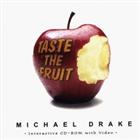
From his German ancestors, Michael Drake inherited the blonde hair, blue eyes and a work ethic that drives him to perform hundreds of shows a year. But his balmy calypso tunes are descended directly from the music of the Caribbean islands. The Milwaukee musician acquired a taste for Latin rhythms while traveling to the Caribbean more than a decade ago. On family vacations the veteran horn player would pack his instrument and sit in with local bands, soaking up the party-friendly musical style of tropical dance music. “The cumbias and the Merengues and the cha-chas just seemed to be more interesting, more of a flavorful experience for me,” says Drake, who just released his fifth album, “Taste The Fruit." That love of Latin revelry is evident in Drakes energy infused shows. Each performance is an audience-participation fiesta, with conga lines and Hulu hoop and limbo contests to keep the crowd on its feet. “Onstage, I do percussion, vocals and trumpet, and dance around like a nut,” says Drake, who has 31 years of professional music experience. He calls upon a revolving pool of musicians to back him up live and in the studio. This summer the full-time musician will adhere to a grueling tour schedule, rocketing around town to hit as many as three stages a day. He'll perform at Summerfest June 30 and play a 10 night stint at the Wisconsin State fair in August in addition to numerous festival and nightclub appearances throughout the Midwest. “I'm the show man, the gig-meister, as they call me around here. It's the German influence, I guess,” says Drake, who has played about 250 gigs a year for the past three years. Summer is the musicians’ busiest season, but his fiery rhythms are also in demand in the winter months to generate a little heat for the shivering Wisconsinites. Drake himself escapes the worst of the icy weather by heading south for several weeks to tour the Florida Keys. No matter what the season, Drake wants his spicy music to give listeners a taste of the Tropics. “Taste The Fruit” which doubles as an interactive CD ROM with video clips and soundbites from Drake’s four previous albums, also offers a feast for the taste buds as well as the ears. The disc includes nine Island-inflected recipes created by Robert “Bob-a-loo” Weiss, owner of Shaker's restaurant. After years of drinking in the musical and culinary traditions of the islands, Drake says his most recent project finally allows him to blend two great passions. “Food and music that's life.” he says.
Shepherd Express 1998
Michael Drake’s Endless Holiday
By Dave Luhrssen

Michael Drake remembers clearly his first public performance as a musician. It was 1968, and his band entertained the crowd in that New Jersey VFW hall with what was then a relatively recent hit, the loopy dance tune “Limbo Rock.” “I'm still playing that kind of music today,” says the trumpeter, vocalist and band leader. “I'm still doing the limbo as part of my schtick.” Michael Drake's schtick, as an entertainer one might expect in the lounge of a Caribbean cruise ship, is well represented on his new and third CD “Taste The Fruit.” He calls what he does “vacation music,” a creamy drink blended from one part Latin rhythms, one part Jamaican rhythms and one part smooth jazz. The umbrella in this tropical drink is Drake’s knack for stirring up breezy melodies. Although Drake sounds as if he worked as Jimmy Buffets deckhand after school, he came to Milwaukee with his parents in his late teens. He played in Warren Wiegratz’s CYO band “Family at Max,” but also sought out opportunities to jam with Latin salsa bands. He sharpened his chops playing fusion with Nexus through the late 70s and scored a local hit in the early ‘80s with a single called “Jessica,” a Chuck Mangione-esque tune that reached number 4 at WLUM, eons before it became New Rock.And then the trade winds begin to blow in Drake’s imagination, steering him to the ports he plies today. “I unknowingly cornered the market in Milwaukee,” he says laughingly. Nowadays Drake plays upwards to 20 gigs a week, sometimes juggling two or three shows a day in the summer months. Lately he's been wintering in the Florida Keys, playing poolside in his swimming trunks a tiki hut for his bandstand. His newest CD has an interactive dimension featuring video clips and even a recipe to go with each track. “I do it all. You have to be really lucky to get anywhere as just a songwriter,” he says, “But if you're a businessman, an entertainer and a songwriter, then you've got everything you need. Your self-employed.” Drake has already laid down tracks for his next two CDs. “I'm writing new material all the time but because of my playing schedule, I have a limited time for recording. So when I go into the studio, I have plenty to do. Also, if I write a song today I'd be afraid to record tomorrow because I haven't lived with it yet. The song grows as you grow!” One of the reasons Drake continues to call Milwaukee his home port is the deep talent pool of local musicians he can draw from for live shows and recordings. “If it weren't for the musicians in this town, I’d have to go elsewhere.” he says.
Journal Sentinel 1998
Interactive album is good enough to eat!
By C.E Hanifin
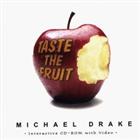
Local musician Michael Drake has always spice his music with the taste of the islands. Now, listeners can sample the tropical flavors that infuse his breezy Caribbean songs. Drake’s just-released fifth album “Taste the Fruit,” doubles as an interactive CD-ROM and features nine recipes created by local chef Robert “Bob-a-loo” Weiss. Weiss, the owner of Shaker's restaurant 422 S. 2nd St., looked to the songs on “Taste the Fruit,” for culinary inspiration, inventing a recipe called “Give Her a Swordfish Martinique” to pair with the tune “Give Her Love.” The offbeat names of dishes such as “Jammin’ Jerk Chicken” and “You'll Never Go Back to Anything But Shark Skin Soup” also allude to song titles. On upcoming CDs, Drake plans to tantalize fans with more gourmet tidbits to a company is a musical morsels. “Savor the Moment” a new album to be released in 1999 will couple love ballads with romantic recipes from eight Milwaukee area establishments. Wine and after dinner cocktail and a cigar suggestions will be contributed by local liquor stores and a Milwaukee area cigar company.
CNI Newspapers 1997
Calypso Sounds of Michael Drake
By Carol Smaglik
Hot Calypso rhythms and a rousing reggae beat will float on the evening air currents Wednesday, when Michael Drake and the No Tan Lines Band take front and center stage at the third CNI-sponsored free Wednesday Night live concert at Wisconsin State Fair. A veteran regional performer, Drake has been called the “Jimmy Buffett of the Midwest” and “King of Calypso” by reviewers. In addition to toe-tapping island rhythms, his high-energy performances usually include lively interactions with audience members as he coaxes all ages into limbo and Hula hoop competitions and conga line fun.
City Edition 1997
"Thirty Years In The Business"
by Tedd Lookatch
Many local musicians dream of a chance to go full-time, dropping their day jobs and being able to survive only as musicians. Michael Drake has made the jump and the reality of being a full-timer in Milwaukee has given him a new perspective and approach. Whereas many bands settle for a couple of shows a month, Drake has averaged about 250 shows a year. "It's not like I'm playing the same bar, doing the same show every night," Drake said. I play many different types of shows, that in it's self makes it interesting." I would be easy to say Drake has sold out, but he'd be the first to tell you he gives people what they want. He books and plays a large number of festivals, corporate events and even weddings to supplement his bar appearances. He'll set up conga or limbo lines, or whatever the client wants. Musicians who are success full because they pander the crowd are criticized, but Drake takes that in stride.
"I write for me and play for the people. If that's a crime, then I'm guilty," Drake said. "The type of music we play needs to have people dancing, singing and having fun, and part of that is the giveaways and the prizes and all those participation aspects that make the show work in a lot different ways." Drake's success has come about by a combination of hard work, good musicianship and timing. His Caribbean-influenced music makes him a niche player in the market. He plays reggae and calypso in a spirited manor, with a flair for authenticity and perfection. Drake's vocals and trumpet lead the festivities, but it's his use of steel drums, congas and timbales they provide the flavoring. His music can be performed in different instrumentations ranging from solo, as is the case with some of his bar gigs, to full seven-piece arrangements like his recent Summerfest shows. Drake adjusts the band to fit the show. I'm blessed by the quality of musicians that I can play with. These are great performers, like Bibi Rodriquez (La Chazz) and Victor Campbell (KoThi). They phenomenal players to work with," Drake said. "I'm fortunately at a point where I can hand-pick the players for gigs and add what's needed. A wedding usually needs a bass player which we don't normally require. The bigger band is more fun, but it's not always possible for obvious reasons." Drake traces much of his productivity to his 30 years in the biz and the experience he's gained over time. "I've learned that you can have all the talent in the world but if you don't know how to package it and believe in it enough to go on to the next step, you'll never go anywhere in this business," he said. "If you want to make it long term, you've got to have an angle or a specialty and stick with it. Plus you've got to be organized. Without that discipline I would have never gotten this far." Drake’s current focus is on his recently released "No Tan Line" which is all originals. He took his time releasing the CD, his first since "Welcome to My Island" in 1991. The use of more than a dozen guest musicians on the project and utilizing five recording studios slowed it up. It's surprisingly coherent considering the number of variables involved. "I'm A Dreamer" and "Perros Calientes" offer a nice sample of Drake's writing. "Lovin' and Livin' and "Island Stomp are also strong. But it's not all perfection on paradise. "The Cannoli Man" fall short of the others. Using the pepperoni/cannoli guy in songs has become fashionable for local performers. It's the third song this year I've heard glorify the Caddilac -driving, bar-bar salesman. Drake projects a shorter span between albums. He's already got plans for an instrumental version of "No Tan Lines" and a country version titled "No Tan Lines Country." Next summer he's tentatively slated to release "Taste the Fruit" another collection of originals. Making CDs is important to Drake, but his live shows are what keep him going, financially and musically. He feeds off of the chance to play in front of people. "I don't care if I'm playing to a group of suited execs or partyers on a beach- I'm trying to have fun and have the people there have fun. Drake will face a challenge later this month when he plays in Denver for a week. He's hired a backing band, an experiment he will attempt to duplicate in the Florida Keys this fall. "I'm sending out my arrangements and tapes to musicians out there. It's not like jazz or blues were there are standards that allow you to play off. My music doesn't allow for that. I'm having people learn original music," Drake said. "Both of these are exciting for me because I used to live in Denver and will get to play out there again and the Keys are where this type of music is strong. I'm anxious to see the response we get down there." Drake's goal is to develop other markets so he can play a couple of weeks elsewhere without losing a step. "There are so many different angles I can take this thing that it's exciting. I broke into Chicago and have begun to play down there regularly and it was a motivator for these other things," he said. "This is a landmark year for me and I'm going to make the most of my opportunities whether it be with "No Tan Lines" or with the show. It's my 30th anniversary in music and I'm celebrating.
Shepherd Express 1997
Living the Attitude
by Mike Stupak
Michael Drake is sometimes described as Milwaukee’s answer to Jimmy Buffet. Entering his thirtieth year as a performer, Drake continues to mine his fertile blend of calypso and reggae, mariachi and other Latin sounds on his latest CD "No Tan Lines." A classically trained musician with a background in Jazz, R&B and Latin music. Drake moved to Milwaukee in 1971. He was pleased to discover a local audience that loved the same things he did. He manages now to play 250 gigs a year. Along with a cast of talented musicians, Drake sets out to create a complete vibe about the sometimes lost art of relaxing and having a good time. "I live my attitude," he says. "My attitude lives in every square inch of me. When I'm entertaining and audience, I'm a very aggressive entertainer." This aggressiveness translates into a penchant for zany antics during his shows, all designed to ensure audience participation and enjoyment. Drake, who's been know to dance on bars and tables during the course of a performance, keeps it lively by handling out shakers and noisemakers and encouraging even the most laid-back wallflower to get up and dance. "In a show I'm doing my shtick," Drake explains. "I'm running my hula hoop contests or my limbo contests. I've got some gimmicks that I use to help propagate my music because when people hear it, it's unfamiliar to them. The content is new, but the feel is familiar and the attitude is familiar. I use my wireless headphones and I'm out in the audience, shaking people up, putting wigs on them and before they know it, they love the music too." The music on "No Tan Lines" alternates between calypso and reggae-flavored songs, powered by strong rhythms and accessible melodies, with Drake's own tight trumpet playing providing a focal point. What makes "No Tan Lines" especially effective is Drake's original music and arrangements that not only convey the much sought-after "pleasant, balmy atmosphere" but contrast is with crisp, tight horn lines set against smooth background harmonies. "I had gone through this period where people were saying, "You really need to promote this and you really need to get signed," he says. "That can be just crazy. So I talked to quite a few producers and record people who said, 'Listen, you're better off with us finding you.'"
Whitefish Bay Herald 1996
"Drake Will Bring Latin Flavor to Park Series"
by Matt Michaelis
The groves of smooth calypso music aren't heard very often around the Milwaukee area. In fact the chances of hearing the music in a local club are two: slim and none. But don't tell this to musician Michael Drake, whose brand of sunny Caribbean sounds will bring some much needed heat to the area as he is featured Wednesday at Wisconsin State Fair Park. The 7:30 p.m. show in Central Park is a part of the third annual free Wednesday Night Live concert series which is sponsored by State Fair Park, CNI newspapers and Bud Light. Drake whose "Welcome to My Island" CD garnered rave reviews from many local critics from such papers as The Shepherd Express and national publications like Jazziz, has been involved with music most of his life. He began playing bugle in the third grade and later focused his attention on the cornet, fluegelhorn, trumpet and a variety of percussion instruments. Drake's father was an educator whose job took him to many locations. As a result, the family moved many times, living in Arizona, Connecticut, New Jersey, Colorado, Oklahoma and other places. In fact, it was the constant movement that introduced Drake to a wide variety of cultures and interesting music. In high school, he studied Spanish and was strongly influenced by a teacher named Senor Mango. In the early 70's Drake's family moved to Milwaukee, and he's stayed put ever since. While he was attending the University of Wisconsin-Milwaukee, the local music scene caught his attention and he quickly became friends with musician Warren Wiegratz. With his clear affection for Latin culture, it was only natural that his musical endeavors have a Latin flavor as well. Drake's first release was an early 80's single, Jessica" which received a great deal of airplay on Milwaukee radio stations like WLUM. And he's never looked back. Never taking what he does too seriously, Drake enjoys to perform his brand of calypso music for local audiences. He can often been seen at many area clubs and Festivals, warming up cold Wisconsinites with his unique tunes. On stage, Drake is a whirlwind of activity. Backed by an impressive band of talented musicians, Drake clearly enjoys being in front of a crowd. But his fan base is not limited to this region. His "Welcome to My Island" release even earned him fan mail from such far off places as Cadiz, Spain and Africa.
City Edition 1996
On Stage
By Ted Lookatch
Island Music
By Vanessa Mosher
Visions Magazine 1993
"Welcome To His Island"
By Jim Hoen
First-time visitors to the rhythmic island of Milwaukee musician Michael Drake will have a hard time sneaking their worries, inhibitions and musical limitations past the good-time guard at customs. Compared with the often stagnant Milwaukee-area mix of three-chord-rock, barroom blues and country cover bands. Drake's icy, horn-fueled blend of Latin American rhythms is a breath of fresh Caribbean air. On the Independently produced compact disc, 'Welcome To My Island," the captivating Caribbean sound seemingly contradicts the initial impression created by the blond-haired, blue-eyed Drake. "i call it Caribbean dance music.' says the well-traveled Drake. who turned 42 in November. "It's genuine music that comes from reflections of my life. My whole background has been diversity, different parts of the country, different cultural experiences," says Drake about avoiding the more common musical constraints. "That's not to say Milwaukee doesn't have culture. Milwaukee is an incredible cultural melting pot, but people don't take the time to enjoy it and really experience it." Drake's wife of 18 years, Lori Drake, who wrote some of the lyrics on "Welcome To My Island,' Says many people are surprised at her husband after hearing his music. -A lot of people who don't know Michael that know me, assume that he's of Latin descent,' says Lori, adding that she's comfortable with the demands Michael's musical endeavors place on their family, which also includes l6-year old son Adam. 'We're good friends,' site says, -and I'm as goofy as he is.' On the heels of the CD release, Drake's band performed at Summerfest and several other area festivals and clubs, as well as a regular summer patio gig at John Hawk's Pub in Milwaukee. When I heard his hand, it took me right back to Bimini." says Lon Matejczyk, a former Florida resident who gave up the salt, sea and sunshine to return to Wisconsin to work in advertising. "There was a band there called the Calypsonlaris and the only difference was, the band up here was white. It was real Caribbean music with no little umbrellas in your drinks." 'Ifs excellent party music." Matejczyk says. 'It's good-time music. period. It took me right back to a stiff rum drink.' Drake invested three years and several thousand dollars in the "Welcome To My Island," project, which has received favorable reviews in such publications as "Jazziz" magazine and ' Goings On,' a regional entertainment publication. 'I started pre-producing, thinking about 100 tunes that I have,' says Drake. "Then I narrowed it down to 30 and I actually really started ' recording to get an idea of what I might want to do with them. Then, of course. I had to narrow it down to the 11 that I did.' Like many independently produced projects, finances were a factor in the production time, although not necessarily a concern, says Drake, who also is a clinician for the Kenosha-based Leblanc Bell instrument company. ' But something nice about spending time on it, you have a lot of time to sit back and reflect on, each portion of it. We would do a session and then I could sit back and say. 'Yeah, I'm pleased with that.' Then you could feel confident with what was going on in the next session. 'I let that work for me, as opposed to against me. But then again, what the hell was I supposed to do, there not being an alternative: Drake says, punctuating his statement with his Infectious laughter. 'So I let it work to my advantage, which it did." Drake says the commercial return has not yet equaled the effort that went into the project, with the emphasis on yet. "This is a rule of thumb. Anytime you're an artist, you just do not want to keep your art and your craft a secret,' says Drake, who would not turn down an investor to help promote Welcome To My Island. If you keep your stuff a secret, how Is that going to help perpetuate you creating more product. You don't want to limit your life experiences. It you do, you limit your successes." In addition to the musical portion of the project Michael and Lori Drake have had to expand their marketing and promotion expertise. "ifs Just as exciting as writing the tunes because you find new rhythms to deal with," he says. "And believe me. there are a lot of rhythms out there In the business sense' To help promote the project Drake has utilized the striking cover art created by David Schweitzer of Square Dogs on such things as T-shirts, sun visors, coffee mugs and posters.
'What's good about music for me is 1 always retain the category of it being a hobby: he says. " Then you can really do anything you want. If you call collecting elephant toenails a hobby. it's OK. because It's a hobby. If you call It a lifelong passion, they say. 'This cat's weird.' This allows me to play anything, write anything and no one can say anything about it because it's a hobby To help stabilize the financial roller coaster often associated with survival on a local music level. Drake, who also teaches music, has delivered newspapers, drove school buses, worked as a security guard and done free-lance home remodeling. 'I've always done something,' Drake laughs_ ' I need additional income to feed my music, my disease. To create the recorded sound on stage. Drake needs a six-piece band for an absolute bare-hones live performance. with eight pieces a more suitable minimum. Ideally, if the money was there and we had some good backing, I'd love to go out there with about a 15-piece band,' says Drake, who Smuggles in his Hawailan-sided original material amongst audience-demanded cover tunes. White honing his live act in the Milwaukee area. Drake says he hopes to broaden his performing base throughout the Midwest. especially Chicago, Minneapolis and Madison. 'A short range goal is to he able to work enough locally to develop it into a regional thing,' Drake says. ' We're booking dates at different places, some special theme things and promotional ideas to create interest." 'Where would !Like to take It? I'd Just like to let it keep growing: he says. 'It's fun. Incrementally. we make new friends. its like a political campaign. Hi I'm Michael Drake, here's my CD. I also would love to be able to quit the newspaper route.' Drake adds with a hearty laugh. 'That's my short-range goal ... to have to quit extra jobs to pay for it. I have to keep writing. I have to keep recording.
"That's a passion. 11.1 don't do that. I get weird." Drake began playing the bugle In third grade and then moved an to cornet. fluegethom. trumpet and percussion Instruments. 'My father was an educated guy who traveled all over the country doing a variety of things as an educator." says Drake. "We traveled with him and did a variety of things. We lived in Denver. Arizona. Connecticut, New Jersey. The last place I lived In before Milwaukee was Tulsa. I graduated from high school there: Drake then attended Tulsa University. where he exceeded his less-than lofty expectations. "My grades high school weren't the best and this was a private school that I wanted to go to," Drake says. "I took the SAT test, or whatever they were, and they had given me a music scholarship. but I was on probation because of my scholastic ability. But after the first semester I had almost a four-point grade average and was on the dean's list. So they said. wen keep the kid, he's OK.' " Drake moved with his family to Milwaukee the the early 1970s, transferring from Tulsa University to the University of Wisconsin-Milwaukee. He then gravitated toward the Milwaukee music scene, forming still-continuing musical relationships with such well-known Milwaukee. area musicians as saxophonist Warren Wiegratz and bassist Duane Stuermer.
In the early 1980s, Drake released a single titled 'Jessica: that moved as high as number four on the playlist of Milwaukee radio station WLUM. Drake's appreciation for Latin American language and culture has paralleled his music. "In high school, I studied Spanish," Drake says. "Where I really learned it was from a Cuban lady .,. this was In New Jersey ... she was working at a motel and all she spoke was Spanish. So I was her translator for a whole summer. "The Spanish language and culture was already in me from my freshman year in high school. The reason It was so strong was became of a teacher named Senor Margo. He was from Spain. He was a real strong influence on me." "When I went to college and then moved here, it was Just natural for me to seek out Latin people and they would seek me out. It sort of developed into a working relationship. I still work with some of these people after 20 years. "The language was very important to me and so consequently, were the music and rhythms. I always enjoyed that. We've had four or five. vacations in the Caribbean and that also influenced me, The Latin rhythms have always been more fun to me than something like your basic rock beats, even though I've done all of them. "I've worked hard learning my music theory so I wouldn't come across too many closed doors when it came to being expressive." Drake says. "It's like a painter with one color. He's going to do the best he can, but I'd rather have a few more colors. Give me the options. Then, maybe 1 can write in just black and white." "Welcome To My Island" was recorded and mixed at Milwaukee's Firebird Studios by engineer and producer Ramie Espinoza. "His name came up in the Latin community as an early studio and I had done some earlier things there." Drake says. `We liked each other and we talked Spanish from time to time, but it's more than that. He was the ideal person. I had done a couple other projects through him, test recordings, things like that. When it came time to do this, there was only one guy in town I would put my faith in for this concept. He'll go into it and make sure it's right.' In addition to positive reviews, Drake has received fan mail for "Welcome To My Island" freom places such as Cadiz, Spain and Africa. The CD also has received some radio airplay and Is in the rotation at several clubs. Drake's attitude toward fortune and fame Is reflected in and by the music Itself. If it happens, it happens. That's also fine with Lorl Drake. "It's fun," she says.; It's not a heavy statement. You pretend you're on vacation. People can escape for a while" Indeed. Please pass the sunscreen.
By Melissa Waxmonski
The flavorful sounds of the Caribbean floated across the stages of Milwaukee County’s Zoofari conference center heating up Milwaukee's winter wonderland with Caribbean fest it kicked off the musical extravaganza with the upbeat temples of the Michael Drake band the seven piece group organized four years ago played several cuts from there internationally recognized cd “Welcome To My Island” and featured versatile bandleader Michael Drake on lead vocals, percussion and trumpet. Drake a master show man dressed up in a purple suit incorporated the eclectic audience into several of the band’s more upbeat calypso numbers, drawing the crowd into a conga line at one point in the set. Drake’s band clearly demonstrated why it's nominated for two WAMI awards, best Ethnic Group / Artist and Best Contemporary Jazz artist.
New CD reflects lifetime of personal experiences
By Jonathan Keepman
Michael Drake's new CD " 'Welcome to my Island' is basically a culmination of 41 years of my life," said the Bay View musician. The culmination includes many excursions to the Caribbean Islands, a near lifetime of trumpet playing and 25 years in professional music as a player and director. As executive producer of "Welcome", the Bay View resident-is also an energetic promoter. A man short in stature with a gregarious personality, Drake demonstrated, gesticulated and promoted his album during a recent interview. Described in his press release as "danceable Caribbean jazz with vocals and horns," Drake said of his album: "This is a fun-oriented, light-hearted project with Caribbean types of happy feels. "A horn player since the third grade, Drake plays the trumpet, fluegal horn, some percussion instruments and is the lead vocalist on "Welcome." In addition, he co-wrote the lyrics with his wife Loretta, composed the music and is executive producer of the album. Marty Haack, the head buyer of local music at Mainstream Records said, "The CD is very well produced. He's done a great job promoting it. "Drake has sent out approximately 700 pieces of mail, many including copies of the CD to friends, musicians, promoters and deejays in the Chicago, Minneapolis, Denver and Milwaukee areas. Drake has also jockeyed himself onto local radio stations including WYMS and WGLE to discuss his album. Behind the necessity, and his enjoyment of promoting lies his vigor for writing music and lyrics. His press release, which he wrote himself, states Drake "writes with a passion that can do nothing but feed energy from itself."
He described the creative process while composing this way: "The heart has got the heat and the mind has the intellect to organize the thoughts. . .When I hear a motif, a little piece of an idea that comes into my mind -joop!- a whole bunch of drawers open up." Drake said he began with a hundred songs for "Welcome To My Island," narrowed down to 35 to 15 and whittled 15 into 11 tracks. "Once I had those 11 I had to commit to those no matter what I wrote afterward, otherwise I would never get it done." In addition to writing at home at his piano, Drake enjoys working with musicians one-on-one in the studio. Animating his directives with hand gestures Drake instructed a theoretical musician. "A little, a little more zip here, a little bit less there, softer, longer, shorter." If the tune requires added drama: "Just pretend you're, you're dying on this note or pretend you've just experienced. . .childbirth and you're a man!" "Since coming to Milwaukee in '71, I've played with traditional Latin bands, jazz bands, funk bands and rock bands," he said. As a trumpet player he has played at Summerfest many times backing up jazz artists such as Freddie Hubbard and the Jazz Crusaders. A longtime friend and trumpet player for the MICHAEL DRAKE band Kevin Carberry said he and Drake met about 20 years ago at the University of Wisconsin-Milwaukee. Both were enrolled in the music curriculum and played for the jazz ensemble. "One of the highlights was backing up Dizzy Gillespie" during a special UW-M performance in 1972, said Carberry. Drake and Carberry have performed together at area music festivals and collaborated on many projects including a production of a half-hour jazz performance which was televised on channel 10 in 1979. Currently, Carberry plays trumpet with the MICHAEL DRAKE band, which will celebrate its album-release party Feb. 22 at a Racine night club. The band made its Milwaukee debut performing at the First Wisconsin New Year's Eve celebration at Lake Park. The eight piece "live" band, Drake explained, differs from the 12-member group which cut the album, with the exception of the two backup singers and Drake himself. Drake said the availability and personal preferences of the musicians factored into the different rosters. "I needed people who could make the commitment and give that special energy for the live gigs," he said. Before the live gigs, however, were the many jobs Drake has done to support himself and his music. An eclectic list of odd jobs from lifeguard to school bus driver accompanies his musical achievements. "Suffice it to say I've always done and continue to do things that are necessary to stay alive," he said with a throaty laugh. In a more serious tone he added, "You have to do many different jobs to contribute to the cause." Eventually, he said, "I would like to be successful from a monetary standpoint. to be able to boldly be immersed in my music." According to John Dorsey, a music director of the jazz ensemble at Racine's Horlick High School, Drake has contributed to the cause his students. "Michael has been a guest soloist at our annual jazz festival three times since '83," he said noting that Drake was the only performer to make three appearances. Dorsey said Drake's enthusiasm was contagious and "the kids really liked him." The students had the rare opportunity to work with the composer of the music. "The music became very real to them," Dorsey said. He said for each concert Drake made about 15 trips to Racine to work with the students. "Nobody has had the time or was willing to spend the time that Michael has. He's really enthusiastic," Dorsey said. A recent review of "Welcome To My Island" criticized Drake's vocals, but likened his horn playing to a "sort of cross between Herb Albert and Maynard Ferguson." However, perhaps Drake's greatest asset is in his directing abilities. Carberry said, "his real strong point is getting the best out of other people "Michael Drake, his wife Loretta, and 15-year-old son Adam have been living in Bay View for over 15 years — "just a few blocks from the beach," he said with a smile.
JAZZIZ 1992
Multi-instrumentalist Michael Drake invites you to a little tropical retreat of his own design on the independently released "Welcome to My island" With a heavy emphasis on vocals and rock back-beats, the album leans more toward pop than jazz, yet there are some breezy instrumental sections and plenty of spicy Latin beats to warrant a mention in this column. Other than the sporadic appearances of a few guest artists and background singers, the Milwaukee-based artist is running a one-man show here as he provides his own lead vocals, percussion, keyboards, and drum programming. He seems most at home, however, playing peppy trumpet solos on the 11 originals featured. His lyrics may be a bit on the trite side, but it's all done with a good-natured sense of fun.
The Journal Times 1992
By John Mielke
Speaking of CDs I got one in the mail the other day - Michael Drake’s “Welcome To My Island.” “It's danceable Caribbean jazz with vocals and horns,” Drake said. “The basic theme is positive. Everything is upbeat and happy.” During a phone conversation, I asked Drake if he could guess my favorite track. He immediately started singing “She's Good For Me,” and he was right on the money. “ I always liked that song,” Drake said of the last track out on the CD. “When we play it live on the gigs, everybody always likes it. I asked a lot of people if we should include it on the CD and everyone said yes.” The problem with this song is that it's more reminiscent of the roaring ‘20s than the Caribbean. Originally Drake had the tune in the middle of the package, but it seemed to break the flow of the Caribbean theme. “My only recourse was to put it at the end.” he said. Drake has been a clinician associated with Le Blanc Holton Co. in Kenosha since 1983 and has worked with the Horlick High School jazz ensemble and Horlick music instructor John Dorsey.
Le Blanc Bell 1992
Tropical Winds:
by Sarah Stoll

The flamingos might be plastic in Milwaukee, but the island beat is genuine. Milwaukee musician Michael Drake re-creates the light hearted spirit of a tropical vacation on his latest CD "Welcome to My Island, which features a refreshing blend of danceable Caribbean rhythms and quality jazz with vocals and brass. It's upbeat tempo lead one local reviewer to describe it as "music with fantasies of balmy moonlight nights, sun-splashed days and margarita-enhanced hoofing." According to the June/July issue of Jazziz magazine, "There are breezy instrumental sections and plenty of spicy Latin beats. It's all done with a good-natured sense of fun."
Drake and his family began traveling to the Caribbean during the 1980's. "I always took my horn with me and sat in with bands down there. I certainly don't look Latin, and in the summer my hair gets even more bleached out. When I walked in to clubs with all these Hispanic people playing their great tunes and asked to join them, they would always say, 'Oh sure, sure you want to play Johnny Be Good or Proud Mary.' And I would say 'No, I want to play your stuff.' We visited the Caribbean four or five times, and each time a picked up a little different aspect of the music. The bands in the vacation areas have a tempo that is more party-like than other Latin music. Eventually I felt comfortable writing it," says Drake. According to Drake, interest in authentic Latin music and in Latin-inspired music continues to grow in the United States. "What I've noticed is that this music keeps darting to the surface every few years. Desi Arnez performed to a large audience on "I Love Lucy" in the 50's, Richie Valens gained popularity with "La Bamba" in the 60's, Linda Ronstadt explored her Mexican heritage int the 80's , and more recently, Latin music was rejuvenated with the lambada dance craze and feature film called "The Mambo Kings." Because we've been continually exposed to this type of music, I think tropical music is less foreign sounding to the American ear. These are proven rhythms that have been around for a long time." Isn't this an unlikely focus for someone who grew up in New Jersey, Oklahoma, and Wisconsin? "I didn't just wake up one day and decide 'I'm going to write Latin music,'" says Drake. "I'm 41 years old, and in all these years I've enjoyed a wide range of musical styles- from early Don Ellis, a trumpeter who used to compose works with really off-the-wall time signatures, to the cultural music of authentic Latin bands. But I'm sure that a lot of musical influences started subliminally when I was very young. My father was a music school graduate and held a doctorate in education. Music was always an important part of our family life." Michael Drake begin playing bugle in third grade and quickly moved onto cornet, fleugelhorn, trumpet and percussion instruments. His first introduction to Latin music came when he enrolled in a Spanish language course during his freshman year of high school. “I instantly fell in love with the language, but my teacher Mr. Mango, inspired me to learn more than just language. He taught us more than just language he taught us about Latin traditions, music, history, food and culture too” During those same years, radio stations all over the country we're playing the music of Herb Alpert and the Tijuana Brass. “I remember hearing “Lonely Bull” and “Tijuana Taxi” on the same stations as the Beatles and Elvis Presley. And there was a hit song “The Girl From Ipanema”, a Bossa Nova tune that was getting lots of airtime” says Drake. “I think many different parts of my background came together when I produced “Welcome To My Island” Following high school Drake attended Tulsa University, “Even though I entered with a scholarship,” explains Drake, “I was put on academic probation because of my high school grades. I had been more concerned with being an ‘artist’ then spending time with my studies. But after my first semester at the university, I had a 4.0 grade point average and was on the Dean's list. I thrived once I could be totally immersed in music.” While in school, Drake focused much of his energy on big band music. “One of the original reasons for big bands was to provide dance music. I was captured by the notion of bringing good listening music back to dance.” Says Drake. In the early 70s Drake moved to Wisconsin. “In Milwaukee, my earlier experiences with Latin music were revived because of the strong ethnic diversity of the city. I begin working locally with several authentic Latin bands playing the rhythmic modes of the day. We played all the standards, sambas, mambos, cha chas. One of the things I enjoy most about performing Latin music was the people I worked with. They were genuinely warm, honest family people who simply loved working together. We continued playing on and off for many years at local clubs as well as at Fiesta Mexicana, a local celebration of Hispanic Heritage.” Drake's musical experiences aren’t limited to Caribbean songs. In 1981 he formed his own version of a jazz fusion band and released to record entitled “Jessica” that wound up on the playlist of a popular local radio station, WLUM. In 1982 he began conducting Jazz ensemble clinics at area high schools. ”I feel that clinics are an important addition to the school music program” says Drake. “No matter how dynamic and motivated a band director may be, it's still a nice change to bring new energy into a group. Clinicians can bring a certain electricity to the routine, and they can also bring a seriousness to the ‘work’ of music. I share all facets of the music business with students, writing, recording and performing. Music education has so much to offer students that it shouldn't be seen simply as a vehicle for preparing future professional musicians. It teaches skills that are related to life such a sensitivity to listening,” declares Drake. “When you perform with the group, you begin to develop the ability to subconsciously sense what others are thinking and anticipate their next move. It's the same working relationships with many team athletes have with one another” Drake feels pop music has an important role to play in music education. “I believe pop music is a transitional music; it bridges music appreciation from one stage of development to another. Children begin their music education very early in life with simple nursery rhymes and melodic songs that are easily understood. The next body of music is pop teenage songs. It's so important for kids to have a continuity to their listening. If you try to move them directly from simplistic tunes to classical music, their minds aren't prepared to grasp a lot of the subtleties that are an important part of classical music.” But Drake is quick to encourage students to explore all areas of music. “If you limit your musical experience, you limit your musical successes. Too many people get locked into one type of playing for too long. I encourage students to take on a style, get the energy and feel for it, then they know when it's time to go on to something else. I think that's good advice even for professional players” Whether performing or teaching, Drake always works with his own compositions and arrangements. “I knew instinctively that I would write so,” says Drake, “but I waited until I had enough life experiences to draw from and enough intellect to organize those life experiences. Some younger musicians find that they have the songs in their heads, but they're frustrated because they can't quite get them down on paper. “To me, composing is exactly like hunger, it's an impelling need. Sometimes I have a rhythm in my mind, then out come chords and melodies. But other times a series of words will inspire me. I did a song called “Ellisa,”; I just love that name, and the song followed from there. I let ideas flow in from many different places.” According to Drake, producing “Welcome To My Island” was like writing a symphony.” It took me six months just to decide which tunes to include. I did pre-production on 40 or 50 songs, then I started eliminating them until I ended up with 11.” In the early stages each song was very skeletal, keyboards and drum machine on a studio computer. Then I started putting real parts on, beginning with bass. Like a symphony you have to have a vision of what's going to happen, but neat little surprises occur along the way. After bringing in players we changed and tweaked the music as we went along. The album feels spontaneous and relaxed, but it is also well planned.” Drakes wife Lori of 18 years is credited as writer on Welcome To My Island.” “She helps with my music and was classically trained in piano but is not a professional musician.” Says Drake. His principal estimate on the CD is Holton’s F100 flugelhorn, predecessor to the correct model F101, which he describes as cozy. “I selected a Holton flugelhorn because I wanted a horn to feel close, like I could hug it. The instrument helps me to play dark murky and in the weeds. And I can add on the edge of it if I want to play high “Cs” and “Gs”. The trigger arrangement is great and tuning is easy. It's interesting that when you find an instrument that’s really comfortable, it allows you to pull up the shades and let the light come in with your playing. Other Fluegelhorns that I tried felt large and cumbersome.
Downtown Milwaukee’s Edition Live Wire 1992
By Michael Horne
The evolution of music has brought us to the point where Jamaica can be replicated in venues on the south side. There was a time before the advent of recorded sound where musicians relied upon the ambiance of the hall in which they played to create the musical affect. That's no longer the case! We now have the “Jamaica is everywhere” beach music of Michael Drake to prove to us that any place can be party place. Michael, if he has changed it all, shows constancy, an ability to crank out straight ahead danceable, crowd-enthusing tunes. Yes, it is dance time. And if it is time to dance why not do so with enthusiasm? To our knowledge, there has been nobody who has mistaken this music with non-dance music. As we infer from Drake's press release Michael’s music will “Cure Your Cabin Fever Like A Margarita Slakes Your Thirst!” Is that frozen? Or on the rocks?
Shepherd Express 1992
Jazzing up the ear waves
By Tim Forkes
Jazz gets a kick in the pants from area recording!
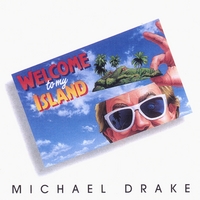
Michael Drake treads some well-known sand, “Welcome To My Island” is the jazzy equivalent of jimmy Buffett. You know what you're going to hear even before the music begins: music derived from the Caribbean with its fantasies of balmy moonlit nights, sun-splashed days and margarita-enhanced hoofing. This is dance music, no mistake about it. The percussion rhythms of “Welcome To My Island” and “Never Gonna’ Leave You” blend into one another like a remixed dance track. His strong suit is his trumpet and flugelhorn, sort of a cross between Herb Alpert and Maynard Ferguson. The high points ae any of Drake’s horn melodies, and the songs “I Wanna Have Fun With You” for it’s funky rhythm and “I Got Your Number” because it features that wonderful horn.
Milwaukee’s Downtown Edition 1992
By Jeff Castelaz
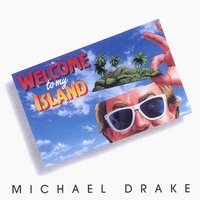
Goings On 1992
By Alyssa Brooke Burris
“Welcome To My Island” by Michael Drake
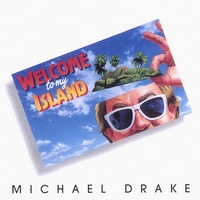
Milwaukee Sentinel, 1992
By Dave Tianen

Milwaukeean Michael Drake's CD “Welcome To My Island” is considerably cheaper than a plane ticket to Jamaica but almost as sunny and festive. Composer trumpeter band leader and a vocalist Drake has put together a 12-track of Jazz-lite party heavy on bright dance rhythms and user-friendly melodies. Obviously Drake has gone to pains to keep the mix within accessible pop boundaries. As a singer Drake is superb trumpeter. Drake the vocalist isn't so much incompetent as he is undistinguished. But almost every tune features a striking trumpet solo. Exceptional tracks include the playfully romantic “Loretta,” the pretty love song “Angel” and the charming period peace “She's Good For Me.”
Who's Being Seen 1991
By James Bryce
The latest release by Milwaukee's Michael Drake, "Welcome To My Island," is an invitation to a musical exodus. The journey is a trip through the Caribbean mind of Michael Drake. Drake, a long-time student of Caribbean and Latin rhythms, tries to give Milwaukee a little taste of his "Island." In his new release, Drake plays the trumpet, flugelhorn and percussion. and does lead vocals. The music is light and happy with a positive theme. Songs like "I Wanna Have Fun With You," "She's Good For Me," and "Still IN Love With You" are almost an invitation an upbeat tropical party. The album slows only once with its sole ballad, "Angel." "Welcome To My Island," shows Drake's technical dexterity and versatility in the music world. His new release has style and high energy, yet it leaves the listener a little hungry. Drake's third release, "Welcome To My Island," will be available on CD only, at all area Mainstream and other area record stores. Drake also has two previous releases.
Racine Journal Times 1991
Jazz artist visits Racine
By Chuck Might
“I would hope that people see through my music sincere interpretations of my life experiences.” These aspirations belong to contemporary jazz artist and composure Michael Drake and offer a glimpse of a personality in which art and life have a symbiotic relationship. Michael is working on his third recording “Welcome To My Island,” which is due out in a few months. He says it will be lighter and happier than his first two releases: Jessica (1980), which reached number 4 on WLUM's playlist, and “Life Stories Vol. 1” (1987) which Guy Arnston of WAM magazine described as a modern urban soundtrack concerned with the melodies of living. Michael says, “I've been composing for years and I've got so much material it took me half a year just to pick out the right songs to create a setting.” Once the material was chosen, Michael took the recording process even more seriously. “I'll go down to the beach and imagine placing every grain of sand where it belongs - that's what it's like to produce a recording.” Michael says. “A note by itself means nothing, but it's the delicate sequence of notes that gives it meaning as you paint the picture with your palette of colors.” Impressed with his compositions and progress on the flugelhorn and trumpet, LeBlanc Holton Co. signed Michael to its High School Guest Series. The series brought Michael to many high schools, including three appearances at Horlick. He led his own band which you can see Friday and Saturday at “Teaser’s” - for more than 10 years holding house jobs at the “Bull Ring”, “Dr. Thrills”, “Up An Under Pub” and “John Hawks Pub.” The band has opened for national acts like Cab Calloway, Freddie Hubbard and The Crusaders.
Journal Sentinel 1987
By Guy Arnston
Top Milwaukee-area jazz ensemble clinician Michael Drake sprang into the Wisconsin spot-light with the pre-Sweetbottom Family at Max group over a decade ago. The trumpeter and flugelhornist first entered record stores in 1980 with his "Jessica" single; now he offers a 30-minute set of introspective instrumentals and low-key vocals called Life Stones Vol. 1. Available only on cassette, Drake's relaxed horns and linear arrangements tell his tales with the sort of familiar ease that stems from true love---of life, music, family. "Dreams," like most of the handful of tunes anchored by Oceans' Duane Stuermer's bass, strays into early Return to Forever territory, thanks in part to Yvette Blue's vocal harmonizing with Drake. Available only on cassette, Drake's relaxed horns and linear arrangements tell his tales with the sort of familiar ease that stems from true love—of life, music, family. "Dreams," like most of the handful of tunes anchored by Oceans' Duane Stuermer's bass, strays into early Return to Forever territory, thanks in part to Yvette Blue's vocal harmonizing with Drake. Steve Lewandowsld's guitar chording and Bill Feldman's cymbal work set the pace for "After Dark," alight-hearted romp through any city's downtown nightlife district, carnival atmosphere intact. Drake's understated vocals keep the jazz feel without becoming distracting. "My Family" is as totally integrated an ensemble piece as its title suggests, and "Winters End" aptly conveys the personal joy one feels when the snow melts and spring begins to rear its head. Not as funky as Herb Alpert's latest, nor as mundane as Mangione's, Michael Drake's Life ' Stories presents a modern urban soundtrack concerned with the melodies of living. Listen closely, and his music will come alive.
Milwaukee Journal 1983
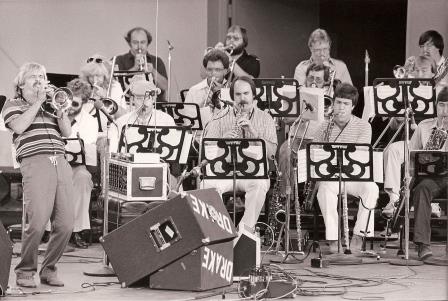
Opening doors through school
By Jim Higgins
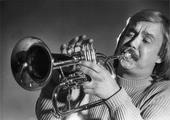
Journal Sentinel 1982
Rock, Disco, Funk, Jazz---Michael Drake plays it!
By Lennox Samuels
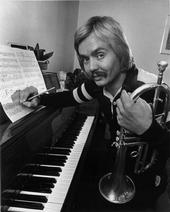
Michael Drake describes himself as “more of a jazz artist, with a knowledge that in order to get things played on radio you have to have a commercial leaning” Drake's current release, “Jessica,” is an expression of that philosophy. The extended-play disc is a moody ode to the singer-songwriter's niece, with Drake's horn setting the tone. With the steadily Latin-based pattern, the style is reminiscent of Chuck Mangione. “’Jessica’ is sort of a Latin thing,” Drake said. “A lot of people should relate to it rhythmically because of the patterns popularized by Mangione. “But the melodies and harmonies are genuine inspirations from my own life experiences. I was happy Mangione made it big, because it makes it easier for somebody else who has those kinds of ideas and aspirations. At 29, Drake is one of the growing number of Milwaukee-area performers who are turning to the recording studios on their own initiative in order to reach out to the public. Drake, who lives on the city south side with his wife and their young son, works a late shift as a security officer to help “keep the roof there.” Whenever Drake has some additional funds, it's back to the studio, “There so much talent in Milwaukee, a lot of people are working on individual albums right now. I go into Dave Kennedy’s studio, where they have engineer students to practice recording me while I practice recording my new songs. That works because you can't pay to have a band rehearse with you every time you go into the studio to work on a new song.” Drake, who study classical and Baroque music, is played in Rock groups, Disco groups, Funk bands, Big Bands straight ahead jazz outfits and practically everything else. Since he moved to Milwaukee 10 years ago, he has back Freddie Hubbard and the Jazz Crusaders. He was a member of Family At Max, along with current Electra recording artist Sylvia St. James. Family At Max later became Sweetbottom -- without Drake. The musician also was the founder of the jazz group Nexus. “I did all those things to keep working, and also because I really enjoyed the material. If you enjoy it at the time you do it, then you do it.” Drake who now concentrates principally on the fluegelhorn, started playing the bugle – “reveille, taps, that sort of thing” and moved on to drums, cornet and violin, bringing those instruments to bear with all the groups in which he played. “But after studying all those things for nearing 30, I felt it was time to start creating my own music. I always felt I had something to say. It was just a matter of getting the education and the development. This solo career is so satisfying because I know it won't fall apart. With co-op groups, you have a class egos and the groups can disintegrate, people moving into different directions. That bothers you after you put your heart and soul and guts into the group.” Drake, who has about 15 songs copyrighted is planning a full-length album for early next year, which will be a medium funk contemporary side of things. He is working on a novel approach to the project. He plans to get jazz big band arrangements written for all his compositions. He hopes to take those arrangements into area high schools, where he would host clinics, discussing writing, playing and recording, and follow the lectures with concerts featuring the schools’ music students and musicians. I would take it only my drummer and bassist, because they know the feeling, the groove, the beat. But the kids would perform with us.” Drake started writing music “in my head easily 15 years ago.” But in the last two years, the pace has quickened and become stronger. “I have a lot of moods, I feel it's important to let them go. I have to let my emotions flow to get them down on paper. It has to be natural. I don't do drugs or anything like that because the writing would be artificial. I'm glad I’m married and have a child because they enhance my life and my writing. Lately, recording and promoting “Jessica” have taken me away from writing and practicing my instrument. But in the meantime, I still have to play gigs and sound great.”
Milwaukee Journal 1980
Trumpeter Drake a very busy man
By Bill Milkowski
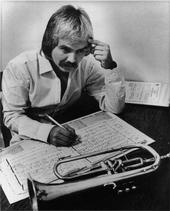
A copy of Walter M. Smith's "Forty One Studies for Developing Lip Flexibility" rests on the piano in Mike Drake's living room. It's re-
quired reading at his house and a must for any trumpet player. He follows the book every day, stretching and contorting his face in
a number of necessary ways. "The muscles that a trumpeter deals with are very pliable," Drake explained. "And when the tissues of
the lip are not in that very unnatural form it takes to play the trumpet, they seem to forget. They relax. So you have to play constantly to keep it flowing." Drake plays often enough to keep his "chops" in good condition, but lately he has been devoting more time to mixing tapes, writing press releases, doing interviews, balancing account books, choosing artwork and contacting radio stations and record
stores. That's because Mike Drake is putting out an album the hard way. After years of acquiring experience as a musician, the 29-year-old Mil-waukee-based trumpeter is producing his own album that he plans to market around the state. He has written all the material,
commissioned the arrangements, chosen the recording studio, hand-picked the musicians and arrived at an appropriate name for the label
Drake Records. Only a few more pieces of over dubbing and his solo project is finished, with release date six months away. But local fans will get a live preview of this forthcoming album Sunday evening at the Jazz Happening '80, sponsored by Milwaukee County in conjunction with the Milwaukee Musicians Association. Local 8. Same musicians who appeared on his album Duane Sturemer on Bass, Jim Sodke on piano, Steve Lewandowski on guitar, Bill Feldman on drums and John Seydewitz on assorted percussion. Drake has traveled extensively and has dabbled in several different idioms. In his early years he hop-scotched around the country with his family, getting a chance to mingle with musicians in Colorado, Arizona, Connecticut, New Jersey, Oklahoma and, since 1971, Milwaukee. Drake said Milwaukee had been a significant stop. "I've been more active here than in other towns," he said. "The opportunities are here, if you go after them. You've got all sorts of ethnic bands here, and it's important to mix with as many as you can if you're interested in growing and maturing as an artist and understanding the total concept of your art. They learn from you, you learn from them." From salsa to soul, disco to Dixieland, rock to jazz and everything in between he's played them all over the last 13 years. "I studied these different idioms on a serious level and developed a genuine interest for each," he said. "You follow through with each until you get what you need out of it. The whole process up through this point in my life has been a logical progression of past musical experiences. It diversifies you and helps broaden your scope as a composer." His latest material reflects his sense of freedom, incorporating a wide variety of colors and moods. There are traces of big band swing or even touches of high-energy music, an idiom he recently explored with a now-defunct fusion group called Nexus. Drake also is negotiating another project for this winter. He plans to conduct a series of workshops with high school bands, allowing students to rehearse his charts with the luxury of a professional rhythm section provided especially for the occasion.
South Suburban Post 1980
Musician hits new chord with first release
By Joan Sobczak
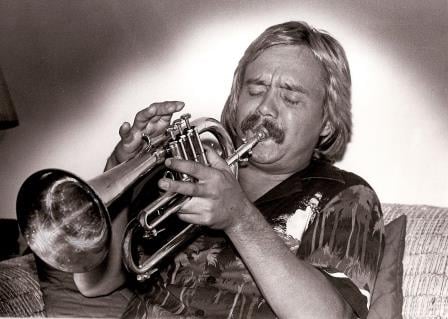
In third grade, he picked up a bugle and played played or at least made some noise. "I really distinctly remember that day," said jazz musician Michael Drake, a former South Side resident. On the other hand he also remembers the day in his childhood when he sat on a cactus. Drake just released his first record a single entitled "Jessica." He composed, arranged, conducted, and produced "Jessica," as well as "Ballad of the Little General" on the flip side. Although Drake couldn't pinpoint exactly when he became interested in jazz, he said, "When I was young, I listened to a lot of different players Al Hirt, Herb Alpert, Louis Armstrong, and Maynard Ferguson. I've been thinking melodies, ideas, and songs since early high school." All of his music is original, and the ideas originate anywhere from driving the highway to taking a shower. "I leave myself open to things around me that will stir something in me, "Drake explained. "First of all, I write a song in my head. In my head I go as far as I can. "Drake plays the fluegelhorn on his record, but he uses the piano to put his ideas down on paper. "I use the piano to give it a realism," he said. Sometimes he gets an idea, but the inspiration isn't there to turn it into a song. Rather than lose the ideas, Drake writes them down and puts them in a box he calls "motives." When he does write a song he said, "I might write a Whole tune in three minutes. Sometimes it Just happens. Sometimes you have to work hard on it, develop it." Drake recorded his first record along with six other musicians. Area radio stations are playing it now, and stores are selling it And his 4-year old son is singing it. "He's a great source of inspiration," said Drake. "He sings all my melodies. "Jessica" blends 16 different tracks into one record, and Drake said combining and balancing those tracks was a little like making a cake. "You mix it all together so it has one flavor," he said. The result in "Jessica,'' is a song in a contemporary sound but with a Latin feeling. "It took about four months to put together that record, including practice and recording time at three different studios. I've been working and building toward this thing for 10 years," said Drake. "I've always wanted to do this." He plans to do a lot more. Drake will offer clinics for interested high school bands, with each clinic followed by a concert. The purpose of the clinic/concert program, said Drake, is to show students "there's more to music than high school. "He's having big band arrangements made of all his compositions so he can use them in the high schools. Drake has already put a dozen of those compositions on tape, but "Jessica/Ballad of the Little General" is his first release. The Christmas season should see the release of his first album. As a performer, Drake enjoys doing different types pf jazz. Pure jazz, I really love doing that because it's really free. "Everything's written exactly, afterwards, individual musicians add a little of their own interpretation. When developing his ideas into full length compositions Drake said,"I get working on a project like that, and I can't stop. Your whole energy and chemistry is involved in that composition. You have to always let your feelings be your guide." Never the less, along with that goes a lot of discipline, when you tell yourself to sit down and do it. As he has developed as a musician and composer, Drake says he's less "into" what other artists are doing. "More and more I know what I like as a player and a writer. I listen with everybody more or less on the outside. Now, I'm really into what I am doing. "Drake recorded "Jessica" on his own label. In the future, however, he might accept a record contract. "It'd be nice for me to get a record contract from someone," he said. "I'm looking for the kind that no only releases me but promotes me like they do with movies. "From a business standpoint, Drake sees the advantages of a record contract. Nevertheless, he said, "I'd like to say I did it all on my own "
Milwaukee Journal 1978
 Jazz Band Nexus, TV Station Combine for a First
Jazz Band Nexus, TV Station Combine for a First
 Watch The Video
Watch The Video
By Bill Milkowski
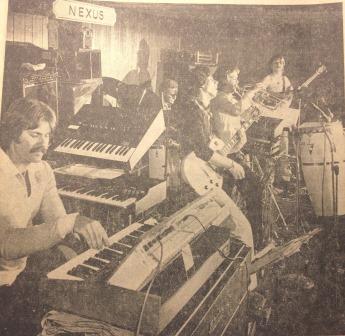
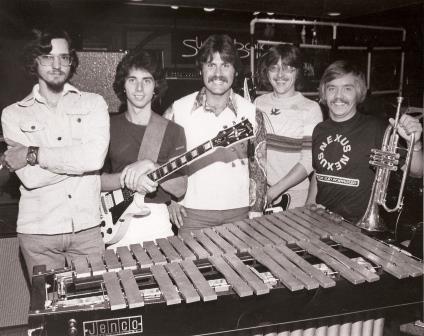
Milwaukee Journal Accent 1977
Group Builds on Musical Talk
By Anne Mason
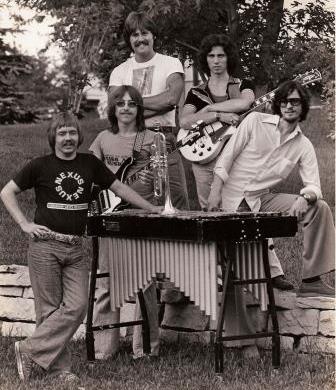
There is a new language being communicated in Milwaukee. The language of Nexus. According to the dictionary, the word 'nexus' means interconnection. In terms of Milwaukee, Nexus is the newest in high energy jazz groups. But the dictionary definition does apply, for the group's primary concern is a close musical and philosophical connection between members. Such a relationship is the basis for successful communication with listening audiences, say the five Nexus musicians. And that, after all, is what the music business is all about. At least that is what it is about to Nexus trumpeter, Michael Drake. Drake is the group's leader by way of his front position in the Nexus stage formation. Strives for Feeling "Music is a means of expression," he explained. "And as musicians we want to get the feeling across." What comes across at a Nexus gig is high energy, but never hyper jazz. The music is like an excited child full of vim and vigor. Yet even when the sound is really cooking, there is a rhythmic call simmering underneath. "We have tried to avoid a nervous sound," said guitarist Danny Torroll. He noted that Nexus drummer Ding Lorenz is especially bent on keeping the group's energy from becoming frenetic. It was with Lorenz and trumpeter Drake that Nexus had its beginning four months ago. To make that long and complicated story short, let's just say Lorenz and Drake were old playing partners who happened upon three musicians in search of a group: guitarist Torroll, bassist Rick Nieznanski and keyboard artist Keith Montross. "It's amazing how fast we were able to come together as musicians," said Montross who is credited with naming the group. "To play well together, musicians must connect in terms of both ability and attitude," he added. "And we do." The Nexus connection is the result of the members' willingness to lend an ear. "Musically, it has been similar to learning a language," said Drake. "Each of us listens to what the other says on his instrument." Conversations In Music Much of the group's playing is characterized by instrument conversation between electric guitar and keyboards, for example. But conversation among members themselves is just as common. "We sit down at least once a week, to talk and plan," said Drake. "It's healthy, just like in a marriage." In the beginning, It was decided that Montross would be the star composer, with Drake and Torroll doing the arranging of already written music. "Both Dan and I would like the time to do some original things," said Drake. "But, we know Keith is a good writer, so we say, 'Okay.' "Taught Music Montrose, a former grade school music teacher in the Whitefish Bay School System, has given the group five original pieces. Among them are: "Indigo Passions," a cool number jazzed up by light and lively keyboard rhythms; "Jamaica Sunrise," a tone poem or musical description of arise-and-shine mood; and "Merb," a mellow piece lifted by feathery percussion sounds. Among the group's favorite recorded sounds are those of Chuck Mangione, the Becker Brothers, Pat Martino and George Duke. Nexus renditions of such music go heavy on the percussion as do Montross's compositions. "All of us play percussion in one number or another, "said Drake. But drummer Lorenz, who has a private collection of an estimated 750 to 1,000 percussion instruments, is definitely the specialist. Each Tuesday when the group sets up for its three set show down at Giorgo's, 6869 W. Forest Home Ave., Lorenz brings with him vibes, a marimba, a timpani, bongos, gongs, a glockenspiel,. a Chinese bell tree, a Chinese fertility drum and, of course, basic drum set. It is in the playing of these; percussion instruments, especially by Lorenz, that the group's energy is kept from becoming frantic. But calm does not mean anticlimactic. In fact, climax is a major part of the group's character. Formula Used! "We use a build and release formula," said Drake. "We use it throughout the night, within sets and within individual numbers. It gets the audience involved. "Our biggest applause always comes at the end of a high point in the music. "It's like riding a horse that wants to run. For awhile you hold back on the reins. Then you let go. That way the run is more exciting. "Exciting Milwaukee audiences to the language of Nexus is the group's immediate aim. "We would like to be able to make a living playing," said Drake, who like the group's other members, holds down more jobs in the music field. Nexus will have its chance to speak to many Milwaukeeans June 30 and July 1 when it appears at the Summerfest Miller Jazz Oasis.
Franklin Hales Corners HUB 1977
5 Musicians Link Talents To Delight of Jazz Lovers
By Peter Grendysa
Every Tuesday night, an enthusiastic crowd of music lovers and jazz buffs has been descending on Giorgi's at 68th and Forest Home in Greenfield, to listen to one of the area's newest combos. "Nexus" is a Latin word meaning link or interconnection, but few in the audience can be expected to dwell for long on the significance of that while the five man group Nexus is performing. "What we play is high-energy jazz," says trumpet player Mike Drake. To those who think of Louis Armstrong or Al Hirt when "jazz" is mentioned, a re-education is offered. Once into the first set of the evening, there is no doubt about the high-energy and the jazz is beautiful and potent. The group has been appearing together only since the end of April, although the sum total of the member's experience in music approaches 100 years. "Unlike many other group," relates keyboard artist Keith Montross, "we hit it off together very well right from the start. There is a certain rapport that is very hard to define and our musical goals are similar." This rapport between the musicians is transmitted to their audience and the ease with which the members slipped into playing together as a tightly-knit team suggested the Nexus title. Nexus originated with Dan Torroll, guitar, and Rick Nieznanski, bass, who had been playing in various groups together for some years. Dan's brother, Mark, is a member of the highly regarded Sweetbottom, Giorgi's house band. Perry Giorgi, owner of the club, asked Dan to form a new band. At the same time, Mike Drake was looking for players for a band and came in contact with Dan.
Nexus was the result. Jazz is the extension and sum of life and Nexus reflects the experience and dedication of the musicians in the group. Mike Drake, a native of Denver and a Milwaukee resident for the past five year, started playing trumpet while in high school. After studying music at the University of Tulsa and at the University of Wisconsin-Milwaukee, he played in several Las Vegas show bands and toured extensively in the United States and Canada. He was, for a time, choir director at St. Boniface church in Milwaukee. Keith Montross of Mequon studied music education at Lawrence college in Appleton and taught fourth through eighth grade music. He is a veteran of several small bands in this area. Dan Torroll moved to Greendale from Chicago eight years ago and attended the Wisconsin Conservatory of Music. He has done considerable road work and now teaches at Brass Bell, Ltd., as does Keith. Rick Nieznanski, a native Milwaukeean, first picked up his bass while in grade school, .played in the eighth grade band and was a member of Milwaukee Tech's Jazz Ensemble. An associate degree in music from Milwaukee Area Technical college and work with local bands followed. Ding Lorenz, percussionist and also a Milwaukeean, is an extra with the Milwaukee Symphony orchestra. He has been playing percussion since the age of 7 and attended Wisconsin College Conservatory. With Nexus, he plays drums, vibes, congas; steel drums and his "gong wall" containing an array of exotic instruments. The first professional appearance of Nexus, following a month of rehearsals, was at the Kenwood Inn, where they substituted for Matrix in the last week of April. Their present job at Giorgi's started May 3 and they appeared for two days at Summerfest. The group is slated to work at the Alewives Jazz festival and will appear at state fair. Their current one night schedule is augmented by four days of practice sessions every week and the results are gratifying to the ear and to the eye. Jazz if the high energy mode by contemporary composers is interspersed with original compositions of varying complexity. All of the members display their particular talents in frequent long solos. Typical of jazz lovers, the audience sits captivated and attentive while the combo is playing and especially inventive solos are rewarded by bursts of applause and cheers. Nexus is helping solidify the growing reputation of Giorgi's as the Milwaukee area jazz spot, a reputation that is spreading nationwide. The group has set high goals of musicianship and professionalism and is striving to produce more original material. Giorgi's offers an ideal setting for their efforts and the jazz fans of Milwaukee will reap the benefits of this partnership.
Milwaukee Journal 1977
5 Jazzmen Take Different Roads, Meet as Nexus
By Dennis Getto

A BLOND, MUSCULAR MAN named Michael Drake stood behind the huge congas, eyeing the sparse audience at Georgi's. He lifted his trumpet, his fingers poised above its valves. He slowly brought the horn to the ear height of his audience, as if he were taking aim with a rifle. Then the room exploded as the five musicians who make up Nexus opened their set with "Butterfly." Rarely does a name tell a story as well as theirs. "Nexus means a coming together from different directions," keyboardist Ron Montross said. A former Whitefish Bay music teacher, who now works at a local music store, Montross is a graduate of Lawrence University who played with an 18 piece jazz ensemble there. He concerns himself with things like the group's dynamics and the esthetics of music. At the other end of the spectrum are guitarist Dan Torroll and Rick Nieznanski, who worked their way up from playing in the basement of Torroll's home. The group came together last spring and has centered its work around a common interest — playing jazz — and a common goal — working five nights a week at what they like to do. AT THE CENTER OF NEXUS is trumpeter / flugelhornist Drake, 26, a far removed descendant of the noted English explorer and sea captain, Sir Francis Drake. The son of Gordon Drake, president of American College in Muskego, he lived everywhere from Colorado to New Jersey during his younger days. In every city, Drake tried to take music lessons. Some of the best he ever received, he recalled were in New Jersey from a trumpeter named Ed Bischoff who was confined to a wheelchair. "He lived in a trailer out in the marshes of New Jersey. He had a hunchback and was missing the thumb and forefinger on his playing hand. And I figured if he could play, I could, too." Later, Drake studied trumpet with Rafael Mendez. After a year at the University of Tulsa and two more at the University of Wisconsin m—a Milwaukee (during which he played with the Family at Max), Drake spent eight months on the road with the Mexicali Brass, a show band that, in Drake's words, played "Tijuana Brass, Dixieland and standards. "It helped a lot in the development of my musical strength. I had to play six nights a week for my lip to be strong. Now I can concentrate on pure musical painting. "I could have gone into acting or theater, but I'm a religious man and I felt that I had to play for 'the glory of the Lord.' I know that sounds kind of schmaltzy, but I just felt it's something I had to do." RICH N1EZNANSKI on bass and Dan Torroll on guitar came up through the rock circles. Torroll is finishing the last three credits of an associate degree in jazz at MATC, He started as did a large number of musicians, playing in a rock band. "Our first job was at some teen center," he said. "Like a lot of guys, I was probably most influenced by the Beatles and Jimi Hendrix." Nieznanski met Torroll in high school, and later played heavy metal a la King Crimson in the same local rock band. Torroll is the third of three brothers to take up music. He studied two semesters at the Wisconsin Conservatory of Music. One brother, Mark, is the drummer with Sweetbottom, Georgi's regular band and the group that produced Darryl Stuermer, who now plays with Jean-Luc Ponty. Nieznanski and Torrell shared an interest in jazz of the type played by the Mahavishnu orchestra and one of its members, guitar guru par excellence, John McLaughlin. "I had been exposed to jazz before," Nieznanski recalled, "but the thing that really got me off on it was hearing the Mahavishnu Orchestra at the first Summer-fest. I didn't know it then, but Rick was at the same concert." Torroll went out and bought their records and began jamming on Mahavishnu music in the basement of his parents' home. "We tried playing a lot of things, but that's what we always came back to," Torroll said. DRUMMER DING LORENZ BEGAN learning drums at 6 and marched with champion drum and bugle corps in his early teens. "When I was l I, my dad would drive me down to Chicago once a week to play with the Cavaliers." The Cays, won the national championship as did the Royalaires, another group to which Lorenz belonged. He also played with Stuermer and toured with the Bloomsbury People, Sigmund Snopek's first group. "Touring is OK, if you can go first class, and if you're staying at good places," Lorenz said. Unfortunately, neither was the case with the group. "I'd never do it again, driving with six guys in a car between gigs," Lorenz said. "It's just no good." Lorenz's teacher in percussion is Tely Lesbines, percussionist with the Milwaukee Symphony, and. he has played in several shows, including ballets and operas. "I can get dressed up in a tuxedo and go down and hit a triangle a couple times with the symphony, but that's just a job," he said. "Here I make lousy money, but every musician has a certain amount of artist in him." "THE WHOLE :THING that ticks me off is that some club owners still refuse to pay you a decent wage because you play jazz. I consider musicians professional people, like doctors or lawyers. They're trained professionals. There's not one person in this band with less than 15 years' experience. "I have from $4,000 to $5,000 in instruments on stage and they could care less." But all the band members know that Giorgi's is one of the better clubs to play, and that its regulars appreciate good jazz. So on any Tuesday night, they put their all into everything from original works like Montross' "Toreador" to better known tunes like Chick Corea's "If." "This band had good electricity right from the begin ing," Drake said of the group's inner working. "And we plan to take it just as far as we can go."
The Ultimate Vacation Spot.
A Unique Talent.
Cures my cabin Fever like a Margarita slakes my thirst.
Cheaper than an airplane ticket to Jamaica.
Tropical retreat.
Spicy Latin beats.
Good natured sense of fun.
Michael's Island of the cheese and
home of the brews.
Master of Island vacation music
The Pina in your Colada.
Fantasies of balmy moonlit nights,
sun-splashed days
and margarita-enhanced
hoofing.
A creamy drink blended,
one part Latin rhythms,
one part Jamaican
rhythms,
one part smooth
Caribbean flavored Jazz.
Fine ear food, balmy calypso tunes,
energy-infused,
Feast for the musical taste buds
Bright dance rhythms.
Captivating
Hippest trumpet player alive!
Bring your dancin’ gear
and beach tongs to his fantabulous island.
Jamaica is everywhere beach music
The Flamingos might be plastic,
but the island beat is genuine.
Heat quenching toe tapping tropical rhythms
Invitation to a Tropical Party
Style and energy
Unique talent
Contagious laugh
and his horn,
has contagious melodies
Visitors to his rhythmic island will have a hard time sneaking
their worries and inhibitions past the
good time guard at customs.
User friendly melodies
Superb striking trumpet solos
Musical beachcomber


